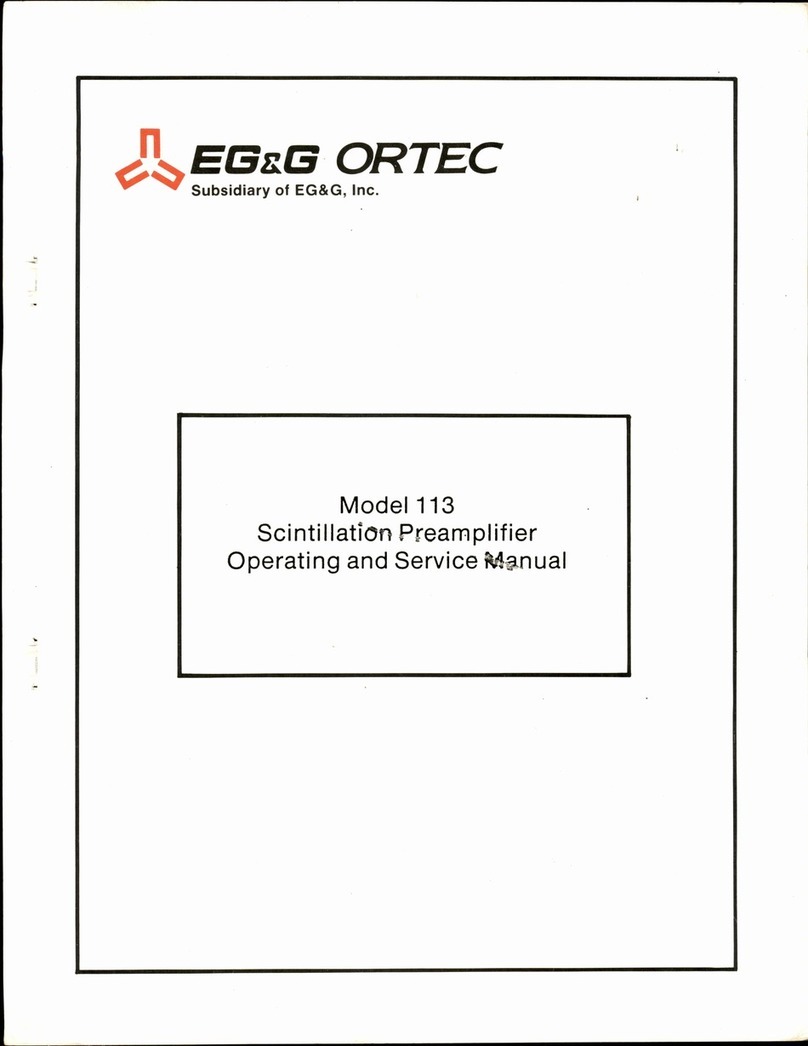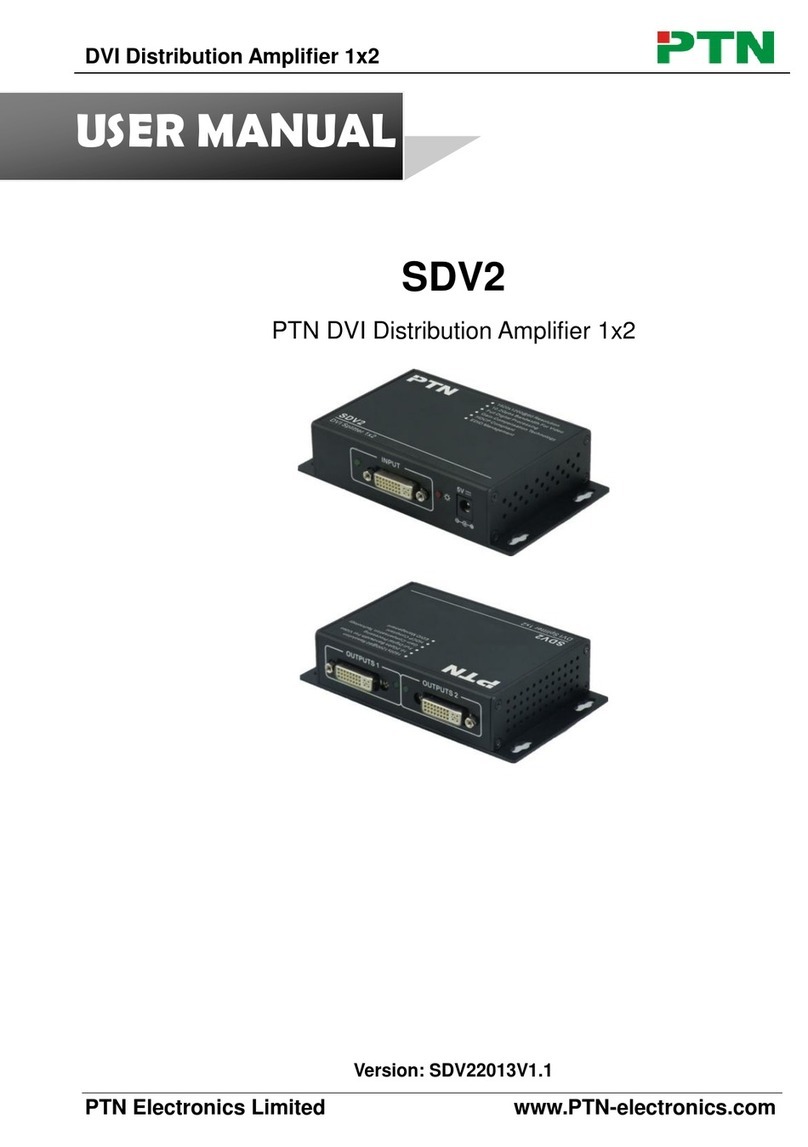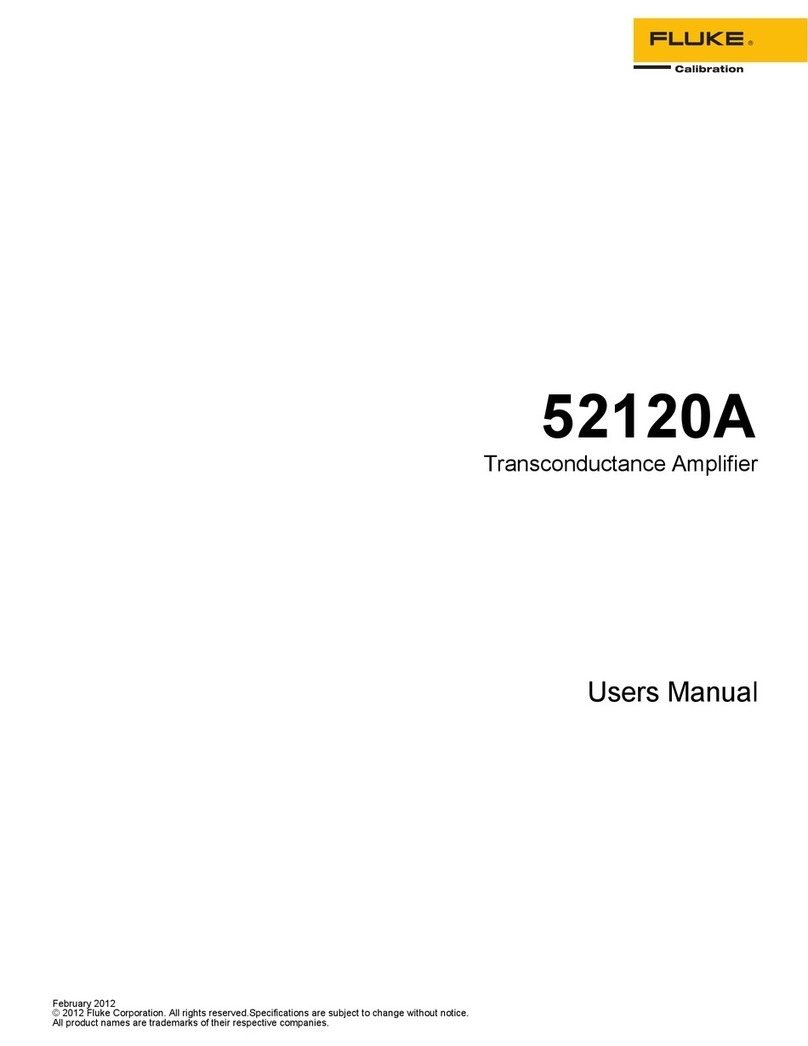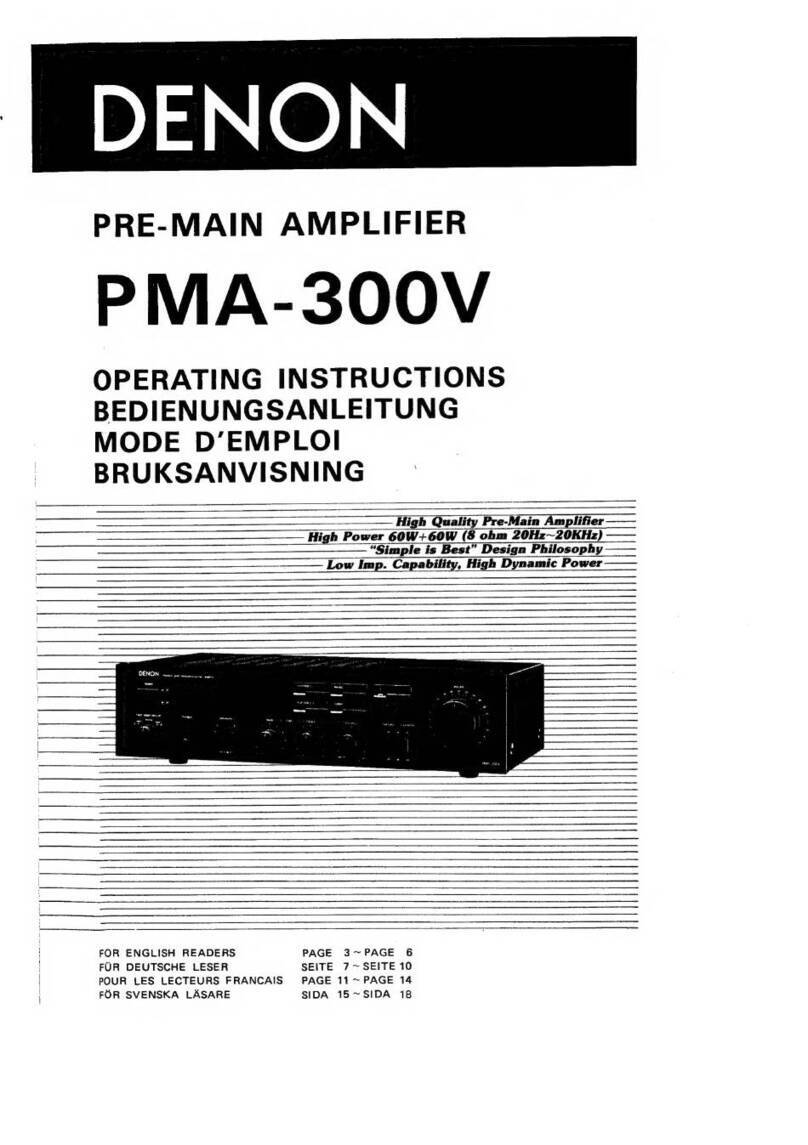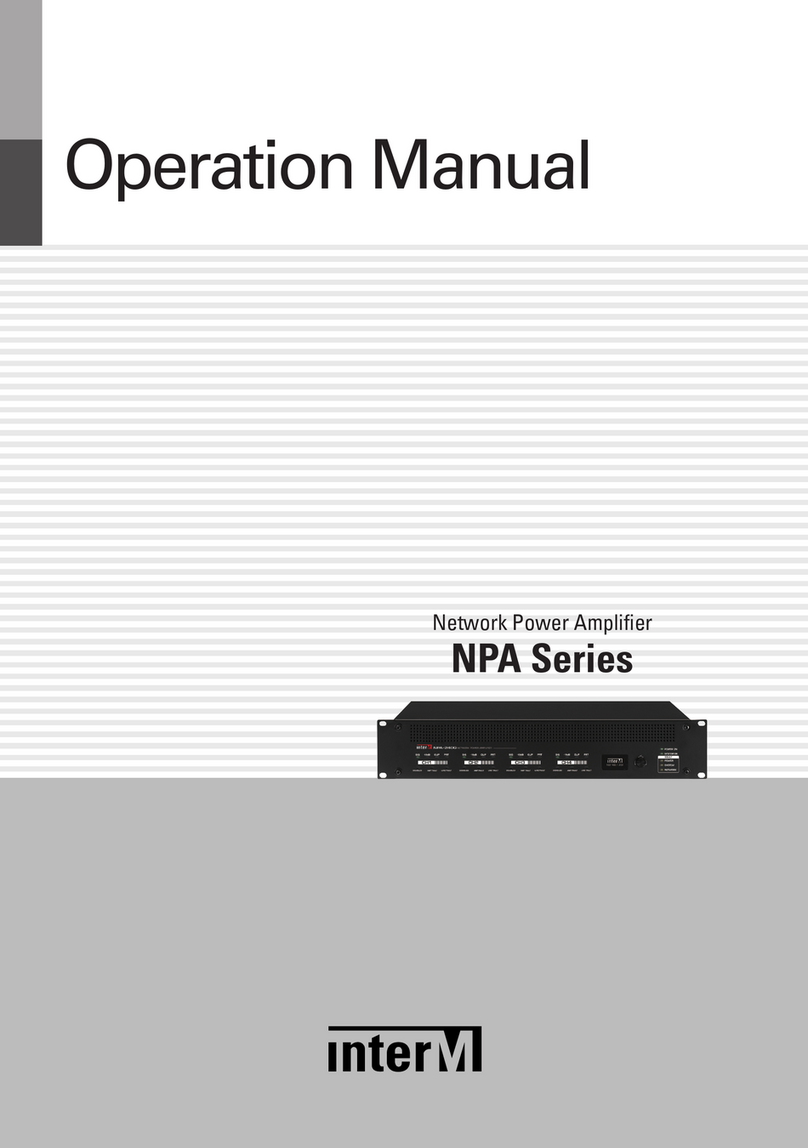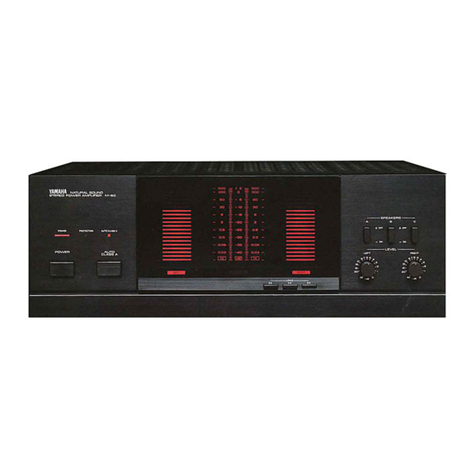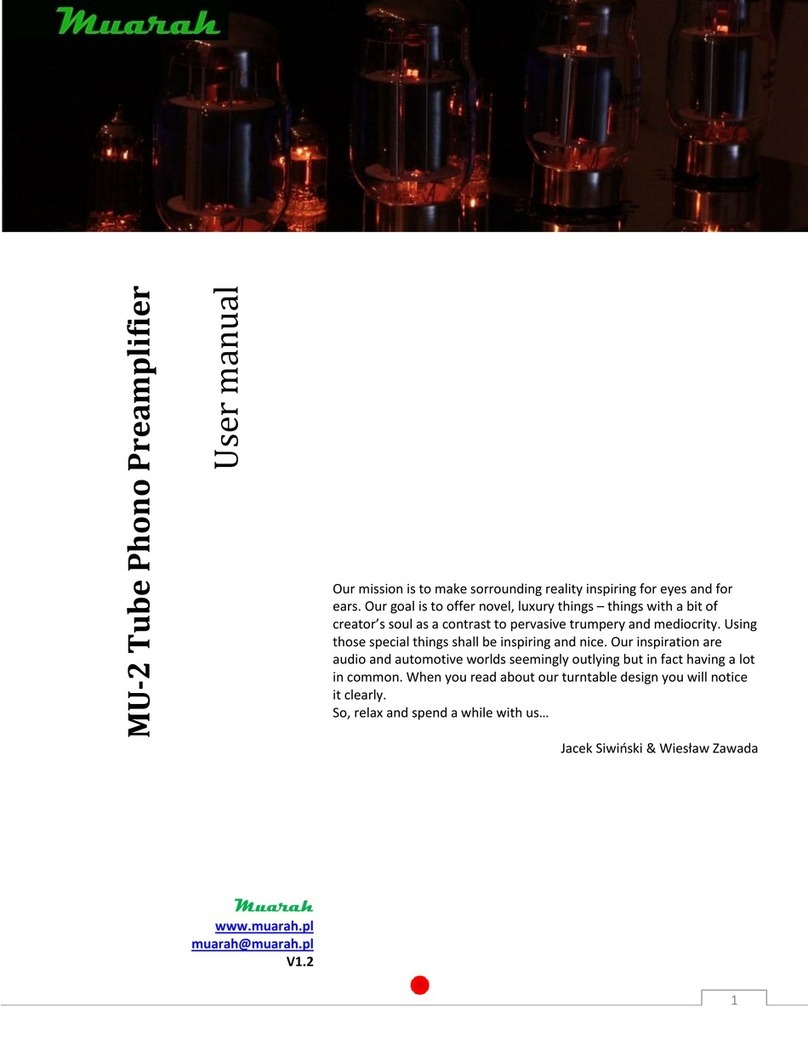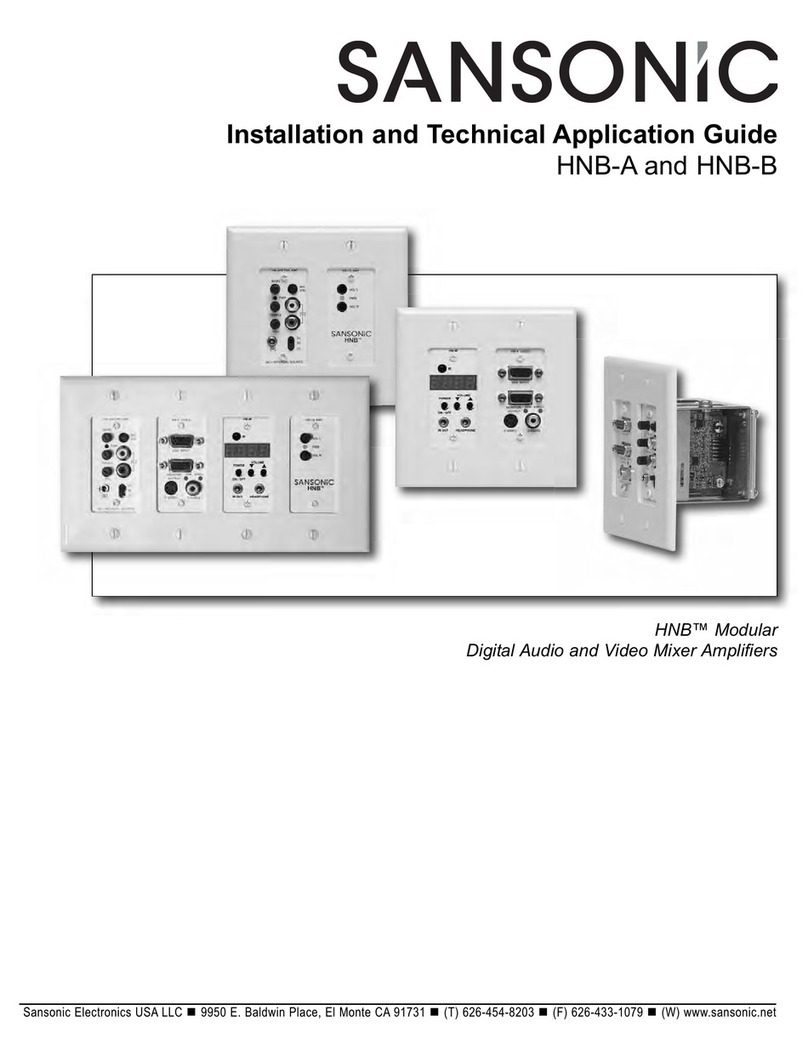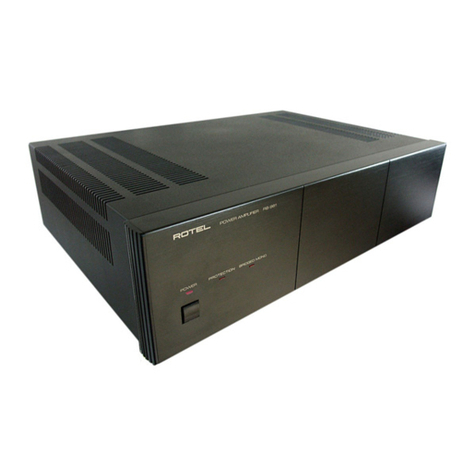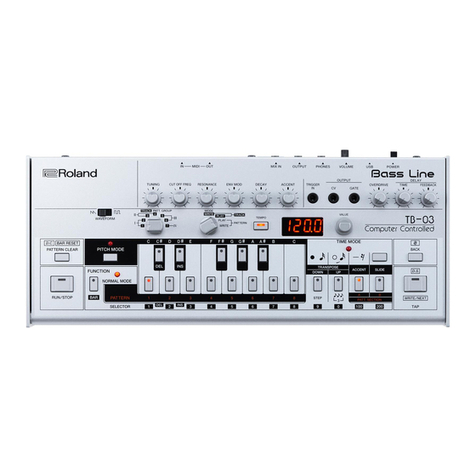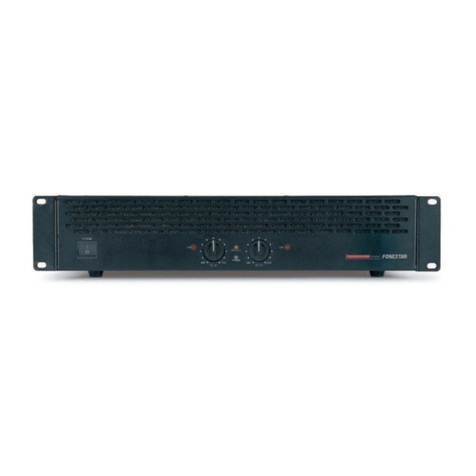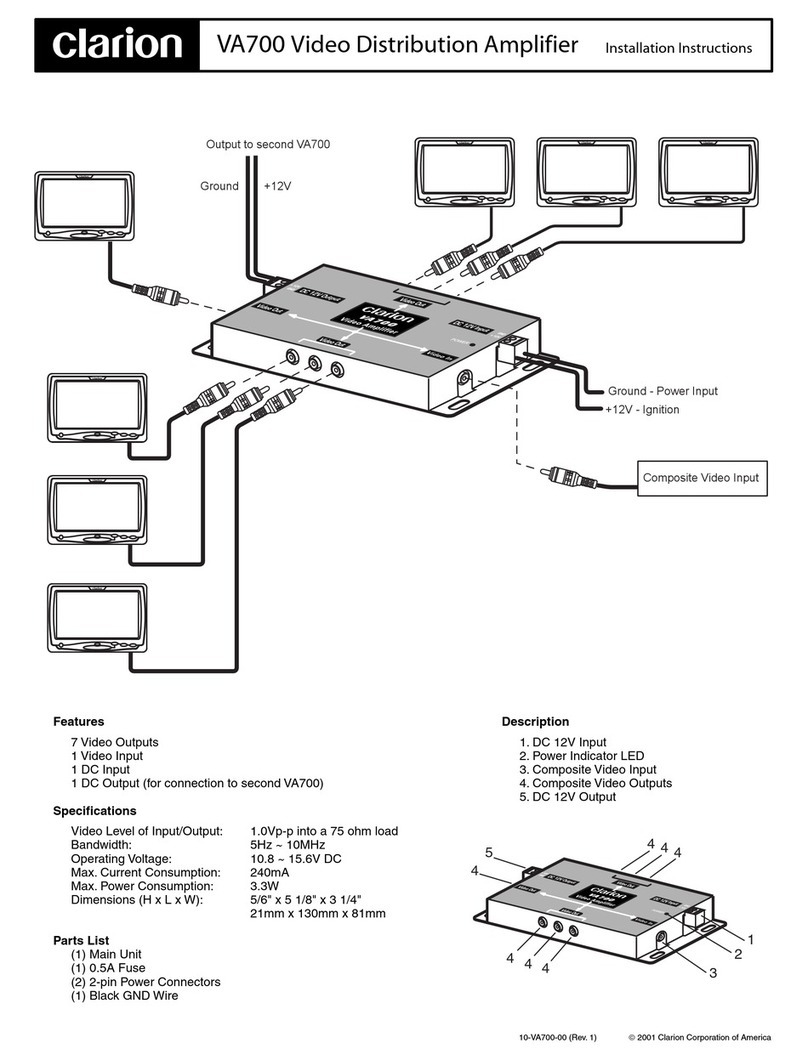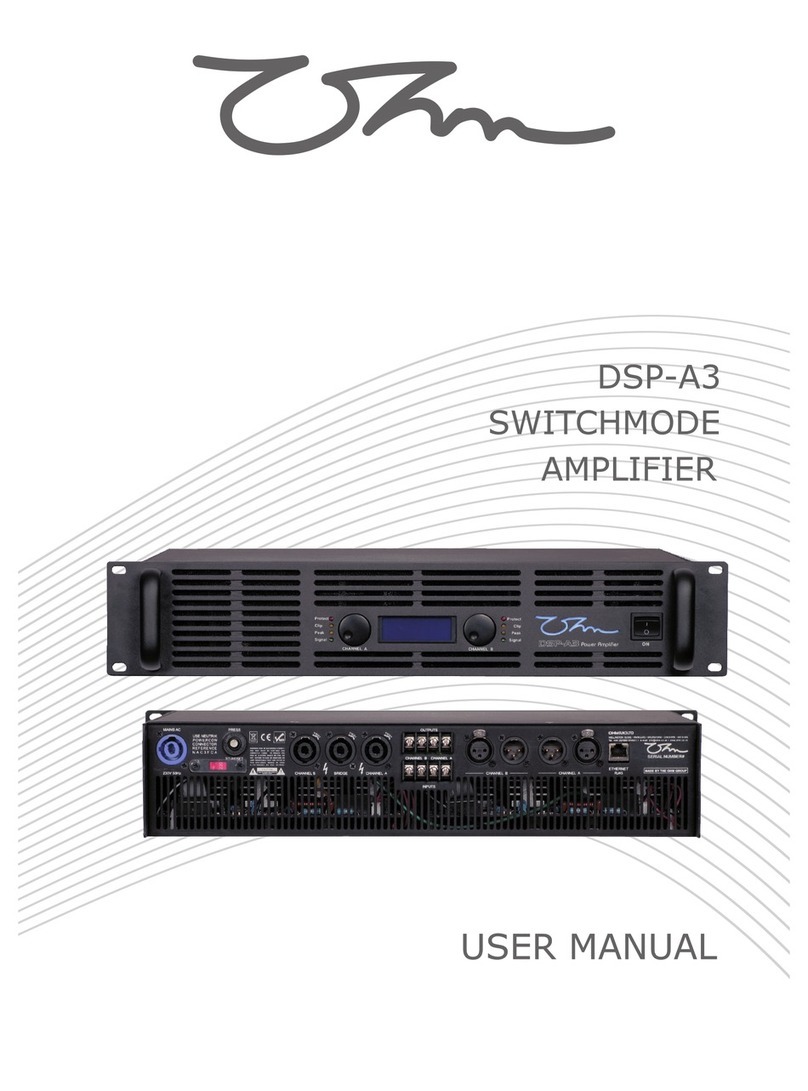EG&G 113 Service manual

Artisan Technology Group is your source for quality
new and certied-used/pre-owned equipment
• FAST SHIPPING AND
DELIVERY
• TENS OF THOUSANDS OF
IN-STOCK ITEMS
• EQUIPMENT DEMOS
• HUNDREDS OF
MANUFACTURERS
SUPPORTED
• LEASING/MONTHLY
RENTALS
• ITAR CERTIFIED
SECURE ASSET SOLUTIONS
SERVICE CENTER REPAIRS
Experienced engineers and technicians on staff
at our full-service, in-house repair center
WE BUY USED EQUIPMENT
Sell your excess, underutilized, and idle used equipment
We also offer credit for buy-backs and trade-ins
www.artisantg.com/WeBuyEquipment
REMOTE INSPECTION
Remotely inspect equipment before purchasing with
our interactive website at www.instraview.com
LOOKING FOR MORE INFORMATION?
Visit us on the web at www.artisantg.com for more
information on price quotations, drivers, technical
specications, manuals, and documentation
Contact us: (888) 88-SOURCE | sales@artisantg.com | www.artisantg.com
SM
View
Instra

MOEL 113
LOW- NOISE
PREAMPLIFIER
SEE SAFETY NOTICE
PRECEDNG SECTION I
BEFORE OPERATING INSTRUMENT
NG AND SERVICE MANUAL
/
MODEL
113
LOW
-NOISE
PREAMPLIFIER
S
EE
SAFETY NOTICE
PRECEDNG SECTION I
BEFORE OPERATING INSTRUMENT
HF
RO
LL
·OFF
H,
300
I..
3.
100\
1/
'0'
.......
,/
-30,
MODEL
11
3
PRE
·
AMP
OPERATING
AND
SE
RVICE
MANUAL

PIdHQUVHSBH Cl3l'lddV NO.L3ONlHd 9793 S86l»@ll|5 Kd OVU 006 88ll- Sl
HJHvslsslaasu'7ddVNOJ.33NIHd £1855“L?
'|VNVW NOl.l.OH.l.SNl CINV 9Nl.l.VH3dO
H3l:ll"ldlI\|V3Hd
HSION ‘M01
an1a<1ow
M113; 1/83·900·RAU
MODEL
113
LOW-NOISE
PREAMPLIFIER
OPERATING AND INSTRUCTION MANUAL
(;;n~EGc..G
PRINCETON
APPLIED
RESEARCH
Copyright
©1983 EG&G PRINCETON APPLIED RESEARCH Printed In U.S.A.

SHOULD YOUR EQUIPMENT REQUIRE SERVICE WARRANTY
A. Contact the factory (609/452-2111) or your local factory EG&G PRINCETON APPLIED RESEARCH warrants each in-
representative to discuss the problem. In many cases it strument of its manufacture to be free from defects in material Q
will be possible to expedite servicing by localizing the and workmanship. Obligations under this Warranty shall be
problem to aparticular plug-in circuit board. limited to replacing, repairing or giving credit for the purchase
price, at our option, of any instrument returned, freight
B. If it is necessary to send any equipment back to the fac- prepaid, to our factory within ONE year of delivery to the
tory, we need the following information. original purchaser, provided prior authorization for such return
has been given by our authorized representative.
(1) Model number and serial number. This Warranty shall not apply to any instrument which our in-
(2) Your name (instrument user). spection shall disclose to our satisfaction, has become defec-
tive or unworkable due to abuse, mishandling, misuse, acci-
(3) Your address. dent, alteration, negligence, improper installation or other
causes beyond our control. Instruments manufactured by
(4) Address to which instrument should be returned. others, and included In or supplied with our equipment, are not
covered by this Warranty but carry the original manufacturer’s
(5) Your telephone number and extension. warranty which is extended to our customers and may be more
restrictive. Certain subassemblies, accessories or com-
(6) Symptoms (in detail, including control settings). ponents may be specifically excluded from this Warranty, in
which case such exclusions are listed in the Instruction
(7) Your purchase order numberfor repair charges (does Manual supplied with each instrument.
not apply to repairs in warranty). We reserve the right to make changes in design at any time
(8) Shipping instructions (if you wish to authorize ship- without incurring anyobligation to install same on units
ment by any method other than normal surface previously purchased. 1
transportation). THERE ARE NO WARRANTIES WHICH EXTEND BEYOND THE
C. U.S. CUSTOMERS—Ship the equipment being returned DESCRIPTION HEREIN. THIS WARRANTY IS IN LIEU OF, AND
to: EXCLUDES ANY AND ALL OTHER WARRANTIES OR REPRE-
SENTATIONS, EXPRESSED, IMPLIED OR STATUTORY, IN-
EG&G PRINCETON APPLIED RESEARCH CLUDING MERCHANTABILITY AND FITNESS, AS WELL AS
7Roszel Road ANY AND ALL OTHER OBLIGATIONS OR LIABILITIES OF
(Off Alexander Road, East of Route 1) EG&G PRINCETON APPLIED RESEARCH, INC_UDING, BUT
Princeton, New Jersey NOT LIMITED TO, SPECIAL OR CONSEQUENTIAL DAMAGES.
NO PERSON, FIRM OR CORPORATION IS AUTHORIZED TO
D. CUSTOMERS OUTSIDE OF U.S.A.—To avoid delay in ASSUME FOR EG&G PRINCETON APPLIED RESEARCH ANY D
customs clearance of equipment being returned, please ADDITIONAL OBLIGATION OR LIABILITY NO“ EXPRESSLY
contact the factory or the nearest factory distributor for PROVIDED FOR HEREIN EXCEPT IN WRITING DULY EXE-
complete shipping information. CUTED BY AN OFFICER OF EG&G PRINCETON APPLIED
RESEARCH.
E. Address correspondence to:
EG&G PRINCETON APPLIED RESEARCH
P. O. Box 2565
Princeton, NJ 08540
Phone: 609/452-2111
TELEX: 84 3409
3
SHOULD
YOUR
EQUIPMENT
REQUIRE SERVICE
A.
Contact the factory (609/452·2111) or your local factory
representative
to
discuss the problem.
In
many cases it
will
be
possible
to
expedite servicing
by
localizing the
problem to a particular plug·in
circuit
board.
B.
If it is necessary
to
send any equipment back to the fac·
tory, we need the
following
information.
(1)
Model number and serial number.
(2) Your name (instrument user).
(3)
Your address.
(4) Address
to
which instrument should
be
returned.
(5)
Your telephone number and extension.
(6) Symptoms (in detail, including control settings).
(7) Your purchase order number for repair charges (does
not apply to repairs in warranty).
(8) Shipping
instructions
(if you wish to authorize ship·
ment
by
any method other than normal surface
transportation).
C.
U.S.
CUSTOMERS-Ship
the equipment being returned
to:
EG&G
PRINCETON APPLIED RESEARCH
7 Roszel Road
(Off Alexander Road, East of Route
1)
Princeton, New Jersey
D.
CUSTOMERS OUTSIDE OF
U.SA-
To avoid delay in
customs clearance of equipment being returned, please
contact
the
factory or the nearest factory
distributor
for
complete shipping information.
E.
Address correspondence to:
EG&G
PRINCETON APPLIED RESEARCH
P.
O.
Box
2565
Princeton,
NJ
08540
Phone: 609/452·2111
TELEX:
84
3409
WARRANTY
EG&G
PRINCETON APPLIED RESEARCH warrants each in-
strument
of
its manufacture
to
be free from defects in material
~
and workmanship. Obligations under
this
Warranty shall
be
limited to replacing, repairing
or
giving credit for the purchase
price, at our option, of any instrument returned, freight
prepaid,
to
olJr factory within ONE year
of
delivery
to
the
original purchaser, provided prior authorization
for
such return
has been given by our authorized representative.
This Warranty shall not apply
to
any instrument which
our
in·
spection shall disclose to our satisfaction, has become defec·
tive
or
unworkable due
to
abuse, mishandling, misuse, acci·
dent, alteration, negligence, improper installation
or
other
causes beyond our control. Instruments manufactured by
others, and included in
or
supplied
with
ourequipment, are not
covered by
this
Warranty but carry the original manufacturer's
warranty which is extended
to
our customers and may be more
restrictive. Certain subassemblies, accessories
or
com-
ponents may
be
specifically excluded from
this
Warranty, in
which case such exclusions are listed in the
Instruction
Manual supplied with each instrument.
We
reserve the right to make changes in design at any time
without
incurring any obligation
to
install same on
units
previously purchased.
THERE
ARE
NO WARRANTIES WHICH EXTEND BEYOND THE
DESCRIPTION HEREIN. THIS WARRANTY IS
IN
LIEU
OF, AND
EXCLUDES ANY AND
All
OTHER WARRANTIES
OR
REPRE·
SENTATIONS, EXPRESSED, IMPLIED
OR
STATUTORY, IN·
ClUDING
MERCHANTABILITY AND FITNESS,
AS
WELL
AS
ANY AND ALL OTHER OBLIGATIONS
OR
LIABILITIES OF
EG&G
PRINCETON APPLIED RESEARCH, INCLUDING, BUT
NOT
LIMITED
TO,
SPECIAL
OR
CONSEQUENTIAL DAMAGES.
NO
PERSON, FIRM
OR
CORPORATION
IS
AUTHORIZED TO
ASSUME
FOR
EG&G
PRINCETON APPLIED RESEARCH ANY
~
ADDITIONAL OBLIGATION
OR
LIABILITY NOT EXPRESSLY
PROVIDED
FOR
HEREIN EXCEPT
IN
WRITING DULY
EXE-
CUTED
BY
AN
OFFICER
OF
EG&G PRINCETON APPLIED
RESEARCH.

L-ll/\ ' '
l'l/\
l'|/\
l'l/\
L'I/\
Z‘/\
Z"/\
Z‘/\
,'/\
,'/\
>'>'>'>'>'
S‘/\
8'/\
S‘/\
Z"/\
Z‘/\
Z"/\
Z"/\
L‘/\
L-/\
>'>'>'>'
ZL-Ill ' '
9-
‘?'°’?°'P°?'<T'<.'“'-9“?
r-\—\—(\|
llll
F"?\'-"1-'
||||
‘-1‘1éIII
95%| uogaa \
S1
'sauvwanos ||/\ 4%
"5U!19Pl°S1!"91!C)P91U!1d 2'9
.. . . . . . .ajnpaaojd
'' ' ' 'u0!1:)np0J1u|
'E)NlJ_OOHS3‘l8O2:l_L IA
' ' ' ' 'a1e1qg|eQ1se_|_AJa11eg 6'9
''uog1esuadLuoQ;;0||0g A0uanbaJ:| q6g|_| 3'9
'UO!1BSU8dLUOQ ;;o||o5 /\OU8b3J:| /v\o-| [9
' ' ' ' ' '''u<>!1@1q!|B:> wee 9'9
''UO!lO8!8H 3pO|/\|-UOUJUJOQ
'!PV 0192 991n°S 9199 _L3d ZV V9 '
'''' ' papaa|\|1uauJdgnb3 3'9
-- - - - - - -Z-9
' ' 'UO[lO|'1pOJ1U| v
'3H(]3C)OHd _LN3|/\|N9l'IV /\
'lgncugg) 1se_|_ Maneg (131;
' ' '1[|'1I)J[Q A|ddng J8/V\Od QZ'17
''(ZV)19!}!|dWV 1"d1"O 8Z'V
(LV) 19!}!ldW991d l9!1U9J9H!Cl VZ'17
'' ' ' ' 'suo!1dg1:>se(] lgnzugg 3'17
'' ' '''/\|dcingJa/v\0d 5'17
'1gn:>1!() A19/xooag-lsed peo|1a/\() gyp
' ' '1!"91!C) 191|!:! HOIIQH (]l'17
' ' 'uogleuguualaq ugeg) Q['17
'uogsswddngdoo-|-puno1g) gm;
'1[nOJ[Q 6ug|dn0Q 1ndu| V117 \
'''uogssnosgq weuegg >|:>o|9 ['17 A
' ' ' ' ' ' NOl_Ld|HOS3(]J.lI)HlO' /\l
'5U0!l99!|ddV l99!P9V\|'°!8 U! Ell |9P9l/\l W140 as Vl'€
.l(-)UJ.lO}SUBJJ_ 1ndu| |eu6g3 eBugsn gyg
--.....-
' ' '' ' ' ' 'Bugmqg pue '1sa1_ 'UO[1B.l8C|() Maneg lyg
'uog1e1ad() J98U!“| L|1[N\ 1ua1sgsu0() |eu6gg 1ndu| u1nu1gxe|/\| ()[_'8
''s1uaw1sn[p\1 0192 sq pue u0g10a[a5 ap0|/\|-uowwog 5'3
S1.N3.|.NOO :|O 3'l8V.l.
U°!1919dO l9!1U919H!C]/Pap“3'9l5U!S 8'8
' ' 's1a1|g:| ssed-q6gH/ssed-/v\0-| [3
''''Ma/\0:>ag 1se:| peopa/\() 9'3
''1uaw1sn[pV 0192 0(] 9'3
ugeg pue a5e1|0/\ |eu6!3 7'5;
--. . --I-8-8
'eouelsgsag aamog pue asg0|\| 3'3
..... . .uouanponul V8
' ' SNO|.LI)HJ.SN|E)Nl.L\7’H3dO Ill
... . . . .ampaaojd 8.z
'pap:->a|\| luauudgnbg 3'3
'' ' 'LlO!1OI‘1pOJ1U| ['3
' ' S>II)3HQTv’|J.|N| ll
' ' suog1e:>g;g0ad3 Z1
"'UO[1I)l’\pOJ1U| [fl
'SC)l_LSlH3_|_OVHVHI) I
TABLE
OF CONTENTS
r Section
Page
CHARACTERISTICS
1-1
1:1
Introduction
1-1
1.2 Specifications
1-1
II
INITIAL
CHECKS
11-1
2.1
Introduction
11·1
2.2 Equipment Needed
11·1
2.3 Procedure
11-1
III
OPERATING
INSTRUCTIONS
111-1
3.1 I
ntrodu
ction
111-1
3.2 Noise and Source Resistance
111-1
3.3 Grounding
111-2
3.4 Signal Voltage and Gain
3.5 Dc Zero Adjustment
111-2
3.6 Overload Fast Recovery
111-3
3.7 Low-Pass/High·Pass Filters
111-3
3.8 Single-Ended/Differential Operation
111-3
3.9 Common-Mode Rejection
and
Dc Zero Adjustments
111-4
3.10 Maximum
Input
Signal Consistent
with
Linear Operation
111-4
3.11 Battery Operation, Test,
and
Charging
111·5
3.12 Rack Mounting
111-5
3.13 Using a Signal
Input
Transformer
111·6
3.14
Use
of
the Model 113 in Bio-Medical Applications
111-12
,...,..
IV
.
CIRCUIT
DESCRIPTION
IV-l
4.'
Block
Diagram Discussion
IV-l
4.1A
Input
Coupling Circuit IV-1
4.1B Ground·Loop Suppression IV-1
4.1C Gain Determination IV-1
4.10
Rolloff
Filter
Circuit
IV-'
4.1
E Overload Fast-Recovery
Circuit
IV-2
4.1
F Power Supply
IV-2
4.2
Circuit
Descriptions
IV-2
4.2A
Differential Preamplifier (A
1)
IV-2
4.2B
Output
Amplifier
(A2)
IV-3
4.2C Power Supply
Circuit
IV-3
4.2D Battery Test
Circuit
IV-3
V
ALIGNMENT
PROCEDURE
V-l
5.1
Introduction
V-l
5.2 Preliminary
V·l
5.3 Equipment Needed V·1
5.4
A2
FET
Gate Source Zero Adj.
V·1
5.5 Common-Mode Rejection Adj.
V-l
5.6 Gain Calibration
V-'
5.7
Low
Frequency
Rolloff
Compensation V-2
5.8 High Frequency
Rolloff
Compensation V·2
5.9 Battery Test Calibrate V-2
VI
TROUB
LESHOOTI
NG
VI-l
6.1
Introduction
VI-l
6.2 Procedure
VI·'
,..
6.3 Printed Circuit Soldering
VI·l
\,,~
VII
SCHEMATICS V
11-'

Number 'Page
cb<.'o<5o§iov<':-ii:-<Lo|i>L~
09>
-'0
-'1
-'3
I‘I‘I‘I‘I‘
LOOO\lO>U'lJ>~
-20
V-1
VI-1
-'2A
-'28
FIGURES
ypical Recovery Time vs Low Frequency Rolloff . . .'
_P Filter Normalized Amplitude Transfer Curve ...
HP Filter Normalized Amplitude Transfer Curve ...
_P/HP Filter Normalized Phase Transfer Curve . . .
Typical Common Mode Rejection Characteristics . . . . . . . . . . .
Vlaximum Differential Input to Model 113 . . . . . . . . . . . .. . .
Vlodifying the AM-1 Transformer for Use with the Model 113 Preamplifier . . .
Frequency Response of Typical Model AM-1 Transformer .. . . . . . . .
Noise Figure Contours for Typical Model AM-1 Transformer . . . . . . .
Schematic of Model AM-1 Transformer (Unmodified) . . .'.
Photographs of Model AM-1 Transformer . . ... . . ..
Frequency Response of Typical Model AM-2 Transformer . . ..
Noise Figure Contours for Typical Model AM-2 Transformer . . .
Model AM-2 Schematic, Turns Ratio 1:100 . . . . . ... .
Phot0ofModelAM-2 ................ .
Frequency Response of Typical Model 190 Transformer ..
Noise Figure Contours for Typical Model 190-113 System . . .
Ground-Loop Current Path ..IV
Solder Removal byWicking ..VI1
..Vl1
Typical Noise Figure Contours for the Model 113 ..ll 1,D
ll-3
II4
II4
ll-4
II4
III5
ll-6
Ill-6
lll6
III7
Ill-7
llI8
lll8
Ill-8
lll9
lll9
lll9
Model190Schematic ............... ..lll-10
Photograph of Model 190 Transformer .. . .Ill-10
B-H Curve &Waveform . . . .. . ...Ill-10
Degaussing Waveforms .. . ..Ill-11
Number
1-1
1-2
1-3
1-4
1-5
1-6
1-7
1-8
1-9A
1-98
1-10
1-11
1-12A
1-128
1-13
1-14
1-15
1-16
11-17
11-18
11-19
11-20
V-l
VI-l
FIGURES
Typical Noise Figure Contours
for
the Model 113
Typical Recovery
Time
vs
Low
Frequency
Rolloff
LP
Filter
Normalized
Amplitude
Transfer Curve
HP
Filter
Normalized
Amplitude
Transfer Curve
LP/HP
Filter
Normalized
Phase
Transfer Curve
Typical Common Mode Rejection Characteristics
Maximum Differential
Input
to
Model 113
Modifying
the
AM-l
Transformer
for
Use
with
the Model 113 Preamplifier
Frequency Response
of
Typical Model
AM-l
Transformer .
Noise Figure Contours
for
Typical Model
AM-l
Transformer
Schematic
of
Model
AM-l
Transformer
(Unmodified)
Photographs
of
Model
AM-l
Transformer
.......
.
Frequency Response
of
Typical Model AM-2 Transformer .
Noise Figure Contours
for
Typical Model
AM-2
Transformer
Model
AM-2
Schematic, Turns Ratio 1: 100
.....
Photo
of
Model
AM-2
. . . . . . . . . . . . . . .
Frequency Response
of
Typical Model 190 Transformer
Noise Figure Contours
for
Typical Model 190-113 System
Model 190 Schematic . . . . . . .
Photograph
of
Model 190 Transformer
B-H Curve & Waveform
Degaussing Waveforms . .
Ground-Loop
Current Path
Solder Removal
by
Wicking
•
Page
111-'
~.
1-3
1-4
1-4
1-4
I
1-4
I
1-5
I
1-6
I
1-6
I
1-6
111-7
111·7
111-8
111-8
111-8
111-9
111-9
111-9
111-10
111-10
111-10
111-11
IV-l
VI-l
.
VI-l

SNOILVOICINI AllHV'lOd H.l.lM 9'ld CIHOO H3MOd ‘l 91"5!:l 'C|§_1_||HQHd
SI NO|.LdHH3.LN| 'IVNO|lN3J.Nl 'SOH3'5)NV(]
SJ.VHVddV EIHL HMVW AVW 'I\'/N||NH3.L H.LHV3 N»
q,Oq,,,,ONO:,G3,q,M,,q,OWWNZN S.L\"/Hddv am acusmo so aoqswq HOJ_C)CI
(“1oH__ao 3/\q'1 03'nv:> os1v)a01:>nc1No0 3/\u3v so 3~n=1 "N09 3/\|lQ3-1-Qad 3H1 :10 NQU-dnaaa.-|-NI XNV
iE)NlNHVM
N
15:5. 'sueau1
3.\#& qsuqo Aue Aq 10 ‘mqnuqquoo puno16 Lquee UIB1
‘‘-uqeuq qquseop 1BL|J, “1a1depe,, ue qo esn Aq ‘qoqonp
Q-uoo 9A!lO91O.Id eqnouqq/vq pqos uoqsuaqxs ue qo esn
\, sum, /Iq paleau eq qou qsnuq uoqqoe e/qqqoeqoqd euq_
'1,oe1uoo punoq Lquee peqqnbeq auq L|1!M pepq/\o1d
1e|1no1a>qoos euq peuesuq sq Aquo qqeus 6n|d pqoa
.I8MOd auq '6nqd p100 1e/vqod euq qo 6uo1d [JUHOJ5
uuee em BIA spew sq uoqqoeuuos a/qqqoaqoqd sum,
3|-q_q 9n-qdNn ‘)qq3;qv$ H()_-_| 'L|O1IMS qaued ‘snqeqedde sum, 01 spew sq uoqqoauuoo .I8L|1O Aue
-nee; eqo sueew Aq paqoaqes sq 95Ql|O/\ euqq euq_ aqoqag '/leqes qoqeqado pue quauqdqnba 10; pun016
Lquee 01, Joqonpuoo e/qqqoeqoqd e01 uoqqseuuoo uo
'HOJ.OEINNOO idNI HEIMOd EIHL OJ. CIEII‘IddV Spuedi->0 1BLI1Sn1BJBddB‘$! 118!!! ‘Sn1B1Bdd9 ISSBIO ‘
OV AOZZ H.LIM NOACIEINHHJ. GNV OV AOIL INOI:I:.I S! ‘E->U!I OB 9LI1 U101! P919Jed0 UQIIM ‘BIL IQIJQW
NOIiVI:IEIdO H05 LEIS SlJ.l:IICIEIE)\1WVCI-EI8 AVW 9'41 ‘(9"19J9ddV 5'!!!/1999!/V 9!U0J19='-1/3 1°! 91119!-U
‘IVFINVW SIHJ. NI CIEISIHQSEICI SJ.\1HddV 3H1. -9J!"b9H /(19198) 8V8 U0!1B<>!I¢I"d OEII U! PQUIIGP SV
iNOI.I.V€) WSINVHOEIW M.EI=IVS '0
-Aqddns .I9MOd oe eul Jo 95B1|O/\
sup, Luoqq uoqqeqedo Joq qes sq 1,uau.qn11suq sq!
1Bl419JnS a>qeu1‘p1oo J9MOd auq uq 6uq66nqd eqoqeg '(]3_|_v53¢|0
|\|Q|_|_Q§'|§$ §Q\'I_|_1Q/\ H§N\Qd ‘Q 38 LON CFIHOHS ll .LVHJ. GNV 3:IVSN 38
AVW .L| .LVHJ. HHSH 'lV|.l.N3J.Od VO.L 3J.VQ|CIN|
OJ. CIHEDDVJ. 38 (TIFIOHS NOl.LVO|:I|H3A A.L3:lVS
ONOOBWMHOWB 3AI.LOEIJ_OI:Id 3H.I. =|o NOILOEINNOOSICI so M)
'99|Q99 1l'IdlnO JO HO:| E)N|J.|VM SJ.VHVddV CIHQVWVG “IHNNOS
mdu! qvufiqs ems!/~ peudde uwq se6e1|<>/\1@u6!u 'HEId 30!/was <1a|=||-qvno A8 (]EII:III;I3A N338
I0 M!l!q!S$0d aux IUHOOOB ow! 9>IB1 IOU S900 SVH AJ.EI=IVS S.LI 'IIJ.N (JEIJ.VHEIdO 38 J.ON
$!HJ_ ‘A Z! ¢DQQQXQIOU II!N\ 8!! IQDOW 9kI19D!$U! (]‘lOHS Sivblvddv (]EI'9VV\IVCI 'S.LVHVd
SIG/\8I 95B1I0/\ 9lI1‘D9108UU00$!D D109 9U!I BU! LII!/V\ -dv CIEIEDVWVCI NI 3AIJ.OEI;I=IEINl CIEIHEICINEIH
PUB D919/v\0d Meueq D91BJ9d0 UQLIM 'P91B19ue6 38 CI'IOQ EDNICINIIOHE) EIAliOEI.LOHd EIH.L
mu we mas 40 @>S<>u1 ueu11eu6!u se6e1|<>/I u<>!u~\ IDNINHVM
uq pue (A139) eeqqo/\ /vqoq-enxa Meqes 12 Aqddns uo
seqqeq >qoous oqnoeqe qsuqee uoqqoeqoqd usqu/vq uq '.I8!.IJEO
Sn1€JBdd€ ‘sq 12141 ‘snqeqedde qqq sseqg peqepqsuos eul Aq uoqqoedsuq 10; JGUIBIUOQ Buqddqus eul e/\es
sq pqnoo gqq qspoq/qq euq ‘p9109UUOOS!p pqoo auqq 01 ems 99 '.I9I.IJBO am q.|1q/v\ wqeqo eeqqq pus Qgvcq
GLI1 L|1!M Maneq qeuqequq sqq uqoqq p91B.l9dO ueu/vq 9993 Aqqlou ‘paqou sq Aue qq 'a6ewep Buqddqus
10; peqoedsuq aq pqnous smeqedde pe/qqeoaq Aq/v\aN
"rqnsaa J.HE)|W ‘HLVEIG NO|.L33dSNI '8
HO AHFIPNI NI i“IS3I:I CI‘IOO HOIHM ‘MOOHS
'IVO|I;IiOEI1EI WOH=I GHVZVH A.LEI=IVS VEISIM
-HEIHLO '"IVNI'9|HO EIHL SV )\J.II:IV1Od EIWVS
EIHL EIAVH J.SW E)'ld HO CIHOC) LN3WEIOV'Id 'esn .I00pUI
-as EIHJ. ‘s>n'I<=| quot) HEIMOd am so uaoo 1°! Paulsep U99‘! SP" Snlwdde P9q!1°$9° Gui
I;I3MOd EIHJ. EIC)V"IdEIH OJ. AHVSSEIOEIN SI _LI ;II
ISNINHVM '“°!1!P“°° 919$
euq queuqnnsuq eul, uqelaq 01 pus uoqleqado eqes
'u6qsep eqqqleduqoo qo ed/<1 pa ='-JJHSUB 01198" 9H1/(Q P9/V\°||°I 9Q 019/\9LI1BLI1$5U!
-AO.IddB ue LHIM paoeqdeq sq pqnous pqoo J9MOd JO -U19/I/\ PUP UQIIPLWQIU! 9"-10$ SUIEIUOO I\?"“9w 9!LI.L
nqd eLq1‘s1e>q:>os1e/vqod aqqeqqe/\e sq; uqq/vq eqqqqed 'U0!1!PU°f> 919$ 9U! D9!Idd"$ U996! 99!! $9!IddB
-woo 1ou sq 6nqd DGDIAOJCI sum, qq '|,e1n6q:q uq pawn IBHUBUJ U0!l0nJ1SU! 9!!!! LIQIUM 01 8!! If->P°W 9LI.L
-snqqq ed/<1 auq qo sq pepq/\o1d 6n|d p100 1e/v\od auq_ N()|_|_Q(]()\;|_|_N| ‘V W
(quaumnsuq 6uq1e1adQ aqoqag peag)
EIOI.I.ON M.EI=IVS
SAFETY NOTICE
(Read Before Operating Instrument)
A. INTRODUCTION
The Model 113
to
which
this
instruction manual
applies has been supplied in a safe condition.
This manual contains some information and warn-
ings
that
have to
be
followed by the user
to
ensure
safe operation and to retain the instrument in a
safe condition.
The described apparatus has been designed for
indoor use.
B.
INSPECTION
Newly received apparatus should be inspected for
shipping damage. If any is noted,
notify
EG&G
PARC and
file
a claim
with
the carrier.
Be
sure to
save the shipping container for inspection by the
carrier.
WARNING!
THE PROTECTIVE GROUNDING COULD
BE
RENDERED INEFFECTIVE
IN
DAMAGED Ap·
PARATUS. DAMAGED APPARATUS SHOULD
NOT
BE
OPERATED UNTIL ITS SAFETY HAS
BEEN VERIFIED
BY
QUALIFIED SERVICE
PER-
SONNEL. DAMAGED APPARATUS WAITING
FOR
SAFETY VERIFICATION SHOULD
BE
TAGGED
TO
INDICATE
TO
A POTENTIAL
USER
THAT
IT
MAY
BE
UNSAFE AND THAT IT SHOULD NOT
BE
OPERATED.
C.
SAFETY MECHANISM
As defined in IEC Publication 348 (Safety Require-
ments
for
Electronic Measuring Apparatus), the
Model 113, when operated from the ac line, is
Class I apparatus, that is, apparatus that depends
on connection
to
a protective
conductor
to earth
ground for equipment and operator safety. Before
any
other
connection is made
to
the apparatus,
the
protective connection is made via the earth
ground prong
of
the power cord plug. The power
cord plug shall
only
be
inserted in a socket outlet
provided
with
the required earth ground contact.
The protective action must not
be
negated by the
use
of
an
extension cord
without
a protective con-
ductor, by use
of
an
"adapter"
that doesn't main-
tain earth ground continuity, or by any other
means.
WARNING!
ANY INTERRUPTION OF THE PROTECTIVE CON-
DUCTOR INSIDE
OR
OUTSIDE THE APPRATUS
OR
DISCONNECTION OF THE PROTECTIVE
EARTH TERMINAL MAY MAKE THE APPARATUS
DANGEROUS. INTENTIONAL INTERRUPTION
IS
PROHIBITED.
The power cord plug provided is
of
the type illus-
trated in Figure
1.
If the provided plug is not com-
patible with the available power sockets, the plug
or
power cord should be replaced
with
an
approv-
ed
type
of
compatible design.
WARNING!
IF
IT
IS
NECESSARY
TO
REPLACE THE POWER
CORD
OR
TH
E POWER CORD PLUG,
TH
ERE·
PLACEMENT CORD
OR
PLUG
MUST HAVE THE
SAME POLARITY
AS
THE ORIGINAL. OTHER-
WISE A SAFETY HAZARD FROM ELECTRICAL
SHOCK, WHICH COULD RESULT
IN
INJURY
OR
DEATH, MIGHT RESULT.
When operated from
its
internal battery with the
line cord disconnected, the Model
113
could be
considered Class
III
apparatus, that is, apparatus
in which protection against electric shock relies
on supply at safety extra-low voltage (SELV) and in
which voltages higher than those
of
SELV are not
generated. When operated battery powered and
with
the line cord disconnected, the voltage levels
inside the Model
113
will
nofexceed
±
12
V.
This
does not take into account the
possibility
of
higher voltages being applied via the signal input
or
output
cables.
D.
POWER
VOLTAGE SELECTION
Before plugging in the power cord, make sure that
the instrument is set for operation from the
voltage
of
the ac power supply.
CAUTION!
THE APPRATUS DESCRIBED
IN
THIS MANUAL
MAY
BE
DAMAGED IF IT
IS
SET
FOR
OPERATION
FROM
110
V AC AND TURNEDON WITH
220
V
AC
APPLIED
TO
THE POWER INPUT CONNECTOR.
The line voltage is selected by means
of
a rear·
panel switch.
FOR
SAFETY, UNPLUG THE
E
L
L=
LINE
OR
ACTIVE
CONDUCTOR
(ALSO CALLED "LIVE"
OR
"HOT")
N
=NEUTRAL
OR
IDENTIFIED CONDUCTOR
E =
EARTH
OR
SAFETY GROUND
Figure 1. POWER CORD PLUG WITH POLARITY INDICATIONS

POWER CORD WHEN CHANGING THE LINE with normal heart functioning. However, recent
VOLTAGE SETTING. Depend'ng on the switch research has shown that dangerexists at far lower
position, either “115” or “230” (both are printed on current levels than was previously suspected. As
the switch) will be visible to the operator. For aconsequence of this increased awareness, and
operation from aline voltage of nominally 115 Vafter acareful analysis of the Model 113 design,
ac, the switch should be set so that “115” shows. EG&G Princeton Applied Research Corporation
For operation from aline voltage of nominally feelsthat it cannot recommend the Model 113for
230 Vac, “23O” should show. use in applications involving human subjects or
patients. In certain situations involving specific
conditions of grounding, internal component
E. LINE FUSE failure, or excessive common-mode input, the
The Model 113 line fuse is located inside the in- high input impedance of the Model 113 could fail
strument. To check or replace the fuse, it is first and potentially dangerous currents could flow
necessary to remove the top cover and also the through the subject.
shield mounted on the inside of the rear panel.
The fuse should be aslow-blow type rated at However, the reader should not get the impres-
either 1/16 A(115 VOperation) or 1/32 A(230 Vsion that the Model 113 is in any wayadangerous
operation). The voltage rating should be 125 Vor instrument to use in ordinary applications. Those
higher in the Case 01 115 VOperation and 250 Vor characteristics that necessitate the advisory
hiélherththe eeee Qt 230V0DeFeti0i1-9h|YeBU$$ against the instrument’s use in bio-medical ap-
MDL OF equh/eteht thee Sheuld be USed- plications with humans are common to most other
preamplifiers as well. In fact, with its low internal
wA|=tNiN(;i supply voltages, capability for internal battery
TO AVOID THE POSSIBILITY o|= ASAFETY HAZ- power with epinpieie independence of the ep line.
ARD FRQM E|_ECTR|CA|_ SHQCK wi-ii(3i-i (3QUi_|3 and extremely high input impedance under normal
REsui_T |N INJURY OR DEATH, |)|$(;()Ni\|EcT operating conditions, the Model 113 is probably
THE PQWER CORD BEFQRE REM()V|NG QR |i\|- one of the safest preamplifiers available for
$"i'Ai_i_|N(3 AFU$E_ i3E(;Ati$E QF Ti-ii; PQTEN- general use. For all practical purposes, it can be
T|A|_ HAZARD, Ti-ii; FUSE Si-|()U|_[) BE CHECKED considered to be completely harmless. The maxi-
AND/OR CHANGED BY AQUALIFIED SERVICE mum internei Supply vpitepee eppiied tp the em-
"|'E(3i-i|\ii(3iAN ()Ni_Y_ plifiers are only i12 V. Even these low voltages
can only appear at the input under very specific
Aprooeoure for geinino eooeee to the fuse operating conditions, and then generallyforonlya
follows. few milliseconds. Aperson inadvertently touching
the input under these conditions would, in
(1) Remove the top oover_ it is eeoureo by egeneral, not even be aware that there was any
single screw on the bottom surface ofthetop- Vettege there at ett ehd hY he etfeteh Qt the im-
oover “tip” et the reer of the inetrument_ with agination could the operator of the instrument be
the screw removed, the cover simply slides ie9eTded ee hethg ih ehY dehgeh
back to where it can be freed from the instru-
ment_ The preamplifier can be used in biological appli-
cations involving animal subjects. However, if the
(2) Remove the shield attached to the inside of eppiieeiipn ie pne in whieh ekin reeieienee is
the rear panel. This shield is secured by adreetivredueed prbvpeeeed.tne pperetprie advis-
einoie eorew at its oenter_ with the ehieio ed to observe the following recommendations if
removeo, the iuee hoioer, iooeteo oireotiy unnecessary risk to the experimental animal isto
above the Line Voltage Selector switch, he evetdeti
becomes accessible. 1(1) Turn the amplifier power on BEFORE making
(3) After oheokino eno, it eppropriete, ohenging any connections to the experimental animal.
the fuse, remount the shield and top cover
before plugging in the line cord and operating (2) set the thput Ceuhtthg ewttehee 01 the Medet
the inetrument_ 113 to GND before making any connections to
the experimental animal. Do not transfer from
the GND settings until after the connections
are completed.
F. USE OF THE MODEL 113 IN 1
BIO-MEDICAL APPLICATIONS (3) Do not turn the power switch on or off while
In the past few years, safety in bio-medical ap- the instrument is connected to the experi-
plications has been amatter of growing concern mental animal.
to both the users and suppliers of electronics
equipment. It has long been known that electrical It may prove helpful to consider the reason for
currents passing through the heart can interfere these precautions. By understanding them, the
3
—_---up
POWER
CORD WHEN CHANGING THE LINE
VOLTAGE SETTING. Depending on the switch
position, either
"115"
or
"230"
(both
are
printed on
the switch) will be visible
to
the operator. For
operation from a line voltage
of
nominally
115
V
ac, the switch should
be
set so that "115" shows.
For operation from a line voltage
of
nominally
230
V ac,
"230"
should show.
E.
LINE FUSE
The Model 113 line fuse is located inside the in-
strument. To check or replace the fuse, it is first
necessary
to
remove the top cover and also the
shield mounted on the inside
of
the rear panel.
The fuse should be a slow-blow type rated at
either 1/16 A
(115
V operation) or 1/32 A
(230
V
operation). The voltage rating should
be
125
V or
higher in the case
of
115 V operation and
250
V
or
higher in the case
of
230
Voperation. Only a
BUSS
MDL
or
equivalent fuse should be used.
WARNING!
TO
AVOID THE POSSIBILITY OF A SAFETY HAZ-
ARD FROM ELECTRICAL SHOCK WHICH COULD
RESULT
IN
INJURY
OR
DEATH, DISCONNECT
THE POWER CORD BEFORE REMOVING
OR
IN-
STALLING A
FUSE.
BECAUSE OF THE
POTEN-
TIAL HAZARD, THE
FUSE
SHOULD
BE
CHECKED
ANDIOR CHANGED
BY
A QUALIFIED SERVICE
TECHNICIAN ONLY.
A procedure for gaining access to the fuse
follows.
(1)
Remove the top cover. It is secured by a
Single screw on the bottom surface
of
the top-
cover
"lip"
at
the rear
of
the instrument. With
the screw removed, the cover simply slides
back to where
it
can
be
freed from the instru-
ment.
(2)
Remove the shield attached to the inside
of
the rear panel. This shield is secured by a
Single screw at its center. With the shield
removed, the fuse holder, located directly
above the Line Voltage Selector switch,
becomes accessible.
(3)
After checking and,
if
appropriate, changing
the fuse, remount the shield and top cover
before plugging in the line cord and operating
the instrument.
F.
USE OF THE MODEL 113 IN
BIO·MEDICAL APPLICATIONS
In
the past few years, safety
in
bio-medical
ap-
plications has been a matter
of
growing concern
to
both the users and suppliers
of
electronics
equipment. It has long been known that electrical
currents passing through the heart can interfere
with normal heart functioning. However, recent
research has shown that dangerexists at far lower
current levels than was previously suspected. As
a consequence
of
this
increased awareness, and
after a careful analysis
of
the Model 113 deSign,
EG&G
Princeton Applied Research Corporation
feels that it cannot recommend the Model 113 for
use
in
applications involving human subjects or
patients.
In
certain situations involving specific
conditions
of
grounding, internal component
failure, or excessive common-mode input, the
high input impedance
of
the Model
113
could fail
and potentially dangerous currents could flow
through the subject.
However, the reader should not get the impres-
sion that the Model 113 is in any way a dangerous
instrument
to
use in ordinary applications. Those
characteristics that necessitate the adviSOry
against the instrument's use in bio-medical
ap-
plications with humans are common
to
mostother
preamplifiers as well.
In
fact, with
its
low internal
supply voltages, capability for internal battery
power with complete independence
of
the ac line,
and extremely high input impedance undernormal
operating conditions, the Model 113 is probably
one
of
the safest preamplifiers available for
general use. For all practical purposes,
it
can be
considered
to
be
completely harmless. The maxi-
mum internal supply voltages applied
to
the am-
plifiers are only ±
12
V.
Even
these low voltages
can only appear at the input under very specific
operating conditions, and then generally for only a
few milliseconds. A person inadvertently touching
the input under these conditions would, in
general, not even be aware that there was any
voltage there at all and by no stretch
of
the im-
agination could the operator
of
the instrument be
regarded
as
being
in
any danger.
The preamplifier can be used in biological appli-
cations involving animal subjects. However,
if
the
application is one in which skin resistance is
greatly reduced
or
bypassed, the operator is advis-
ed
to
observe the following recommendations
if
unnecessary risk to the experimental animal is
to
be avoided.
(1)
Turn the amplifier power on BEFORE making
any connections
to
the experimental animal.
(2)
Set the Input Coupling switches
of
the Model
113
to
GND before making any connections
to
the experimental animal.
Do
not transfer from
the GND settings until after the connections
are
completed.
(3)
Do
not turn the power switch on
or
off
while
the instrument is connected
to
the experi-
mental animal.
It may prove helpful
to
consider the reason for
these precautions. By understanding them, the

1i
'|euu0s1ed 001/ues pe111|enb Aq pe1111a/\ ueeq seq "A|ddns
A12-112s s11 |11un pasn eq10u p|n0L1s sn1e1edde uong 10/v\0d s,1ueu1n11su1 au1 01 A|10e11p asueped
-LU! /v\0| eu6n01u1 pe10auu00 eq p|n0/v\ 1011
'sesse11s -g|dwe eu1 10 1ndu1 eu1 ‘1n000 11 p|n0u3 -u011
uvdsuen we/\es O1 D9109[q"$ ueaq $91-| (v) -!r>u<>vs!u11r\<>qv Buuq PIHOO ‘K|<->>1!|l1r\ u5r\<>u1
‘uogu/v\ se1n|1e1 1ueu0dw00 |eu1e1u1 e|q1ss0d
‘su0111pu00 a|qe10/\e1un 1epun 1210/\es 012 010111 -u1e1p eu1 10 e01n0s 0111 ’
e6e101s pe6u0|01d 01 pe10e[qns uaeq se|_| (9) 1eu11e 010126 eu1u101; u0110un[ ep01p pasegq
p1e/v\101a|du11s ee/116 01 A|1ue10111ns a6ue1 6ug
‘s1ueu1e1nseeu1 pepue1u1 0111 111101100 01 s|1e:| (3) -1e1ed0 |e1u10u 011110 1n0 s1 segq 101ue11n0 6u1
-1e1ed0 11eu111 swuo M012 01 d01p ueo e0ue1
‘eewep e|q1s1/\ s/v\0q3 (1) -s1se1 110111 ‘pese1q A|1ad01d ueu/v\ a0ue1s1sa1
1ndug 115111 A|au1e11xe ue 11q1uxa A0111 u6n0u1
:sn1e1edde 0111 ‘e|d -|v 's101s1sue11 100110-p|e11 ed/(1-u0110un[
-u1exe101‘11pe11ed1111eq 01/(|e>11|s1u0110e101d eul 012 911 |ep0W 9L|1 10 s101s1sue11 1ndu1 aui
'u0!1B19d0 pepua1u1un Aue 1su1e6e pemoes pue
e/\11e1ed0u1 spew aq ||eus sn1e1edde 0111 ‘pe11ed a1n|1e5 1uau0dw0Q |eu1a1u| (9)
-u11 uaaq seu pun016 1111120 01 u0110euu00 0111 Aq
pep;/101d u0110e101d eul 1€u1 A|e>11| s1 11 10/\eueu/1/1 '1s1xe p|n0/v\ u011en11s sn01e6uep 1
33333313 12 ‘(su011e||e1su1 pue s6ugp|1nq Auew u1 u0u1
-“IWHONHV GNV $133530 -H -11100) su1n1a1 pun016 1ed01du11 10 e1e|d11100
-ug L|1!M pesn Bugeq e1a/v\1ua11|n11su1 011111 pue
‘d0|c-map 110us ep|n0L13 'pa1ep1su00 eq 1snu1
‘e10111a1 10/\a/v\0u ‘e1n|1e1e u0ns 10 A11|1q1ss0d
0111 ‘sse|eu11e/\eN '1ue1un11su1 0111 10 0111 0111
‘£3,912 01O<,9L 4° 95°91 W1“! fiuunp 112101/(|e>11|un s1 pue Mllenb 116111 A10/1
eq e1n1e1ed111e11ue1qu1e 011112111 6u1eq 1u1e11su00 JO QEH Iapow eu1u|JewJ0JSueJU9M0d Gui
/§|u0 0111 ‘(A1010121 0111 111011 paseuomd eq ueo s1!>1 ''
5U!1Ul'1OLU >10e1) >10e1 eu! 10 uoueq eu0 pe1e1ad0
eq ueo 1| 's1ue111e11nbe1 u011e|11ue/1 |e10eds
Aue a/ueu 10u seop 911 |ep0|/\| 0111 ‘pe1e1ad0 A101 ualmdwe apouwowwoo em ;0 mdmo em
-1eq ueu/v\ sse| ue/10 pue ‘eu|| 0e e111 u1011 pe1e1ed0 O-'dd
-11ueu1n11sug e101n ug 0111101 eoue 0
“GUM 9119'“ 9MUD 4° u°!1dw"Su°° J9M°d 9WM -LUI /v\0| ese sfmleeiide pee1sL1|1| 1nqJ‘c-Jouegad
N0|-|-V'||1-N3/\ '9 116111 e11q1uxe 10u sa0p'101s1sue11 0111
‘a1e1s S!Lll u| -pesegq-p1e/v\101 s1 101110 au1 10
1101s1sue11 1ndug auo 10 u0110un[ 0126-e01n0s
0111 ‘(eouepadwg e01n0s 0111 u0 ugpuedap
-u011e/\1ese1 1n0u11/v\ pepua1u1u00e1 e10u1 10 puooas e01 spu00es1||1u1 M8} e111011
s1su0g1e01|dde1eu10||eu1esn s11‘s10e[qns uewnu sa->112/1 uogum) |e/\1a1u1 S!l41 6u11nq '1u10d 6u1
L111/v\ esn 101 911 |ep0|/11 0111 pue1u11100e1 10u seop -121:-ado 1ad01d 110111 01sa5e1s 1ndu1 0'41 les 01
u011e10d109 qomeseg peuddv u01e0u11d 91993 1e111|du1e d00| apomu-u0111u100 01.11101 pe11nb
L|5HOL|1 ue/\e ‘1eu1pez1seL1d1ua eq p|n0us 11 ‘ugev -e1 s1 011111 e11u11 e‘pee1su| 'e1e1s 6u11e1ed0
1ue0se1nb 11:->u1eu1nsse A|1ue1su1 10u op s11n0
'a0ueped -110 112 ‘u0 peu1n1 1s111 sq 1e111|dLue eu1 ueu/1/1
-11111ndugau11a/v\0|Aqe1eu1pue‘s11n01101ndu1
ehll 1001010 01 10111101112010 eL|1101ndu1 011112 S1UG!SUBJ]_ UQ-Ulni (1)
squad u0110npu00 /v\0| “uo u1n1,, s10/\e| 10116114
'su11 /\ 1s1 911 |ep0|/\| 0141101111111 1ndu1 epow "||a/v\ se pesn 012 s1e111|du1ee1d 1eu10 a1eu/v\ 1nq
-UOLULUOO 0111 ‘su011e01110eds eu1 ug pelels sv ‘QLL |ap0|/1| 01.11 s1 1e111|du1e 1ndu1 eu1 01011/v\ A|u0 W
10u ‘s|eu11ue |e1ue11111edxe10 5ug1011u0u1 |e01110a|a
1ndu| epow-u0111u10Q 0/\1sse0x3 (11) 1n0 A1120 A|a1es 01 e|qe 1a11aq aq A2111 101e1ed0
1eu1101sue1_L 1e/v\0d (3)
operator may be better able
to
safely carry out
electrical
monitoring
of experimental animals, not
only
where the input
amplifier
is the Model
113,
but where
other
preamplifiers are used as well.
(1)
Turn-On Transients
When the
amplifier
is first turned on, all cir-
cuits
do not instantly assume
their
quiescent
operating state. Instead, a
finite
time
is
re-
quired for the common-mode loop amplifier
to
set the input stages
to
their proper operat-
ing point. During
this
interval (which varies
from a few
milliseconds
to
a second
or
more
depending on the source impedance), the
source-gate
junction
of
one input transistor
or
the
other
is forward-biased.
In
this
state,
the
transistor
does not
exhibit
a high im-
pedance, but instead appears as a low im-
pedance from the input
of
the instrument
to
the
output
of
the common-mode amplifier.
(2)
Power Transformer
The power transformer in the Model
113
is
of
very high quality and is unlikely to fail during
the
life
of
the instrument. Nevertheless, the
possibility
of
such a failure, however remote,
must
be considered. Should a short develop,
and
if
the
instrument were being used
with
in-
complete
or
improper ground returns (com-
mon in many
buildings
and installations), a
dangerous situation would exist.
(3)
Internal Component Failure
The input transistors
of
the Model
113
are
junction-type
field-effect
transistors.
Al-
though they
exhibit
an
extremely high input
resistance when properly biased,
their
resis-
tance can drop
to
a few
ohms
if
their
operat-
ing current or bias is
out
of
the normal operat-
ing range
sufficiently
to
give a simple forward
biased diode
junction
from the gate
to
either
the source or the drain. There are several
possible internal component failures which,
though unlikely, could bring about
this
condi-
tion. Should
it
occur, the input
of
the ampli-
fier
would be connected through a low im-
pedance
directly
to
the
instrument's
power
supply.
(4)
Excessive Common-Mode Input
As stated in the specifications, the common-
mode input
limit
of
the Model 113 is 1 V rms.
Higher levels
"turn
on"
low
conduction
paths
at the input
of
the preamplifier to protect the
input circuits, and thereby lowerthe
input
im-
pedance.
Again, it should be emphasized that, even though
EG&G Princeton Applied Research Corporation
does not recommend the Model
113
for use
with
human subjects,
its
use in all other
applications
is
recommended
without
reservation.
G. VENTILATION
With a power consumption
of
only 5 watts when
operated from the ac line, and even less when bat-
tery operated, the Model 113 does not have any
special
ventilation
requirements. It can be
operated on a bench or
in
a rack (rack
mounting
kits can
be
purchased from the factory), the only
constraint being that the ambient temperature
be
in the range of 15°C to
45
°C.
H.
DEFECTS AND ABNORMAL
STRESSES
Whenever it is likely that the protection provided
by the connection
to
earth ground has been im-
paired, the apparatus shall be made inoperative
and secured against any unintended operation.
The protection is likely
to
be impaired if, for exam-
ple, the apparatus:
(1)
Shows visible damage,
(2)
Fails
to
perform the intended measurements,
(3)
Has been subjected
to
prolonged storage
under unfavorable conditions,
(4)
Has been subjected
to
severe transport
stresses.
Such apparatus should not be used until
its
safety
has been verified by qualified service personnel.

'/\LU 09$
L'\
J
l
"ad/\1 QN9 am smlaauuoo 1ndu| 'uo!1e1ed0 |eg1
-ua1aH!p JO pepua-a|6ugs ‘pa|dn0o op 10 oe 10; 8p!/\O.lC|
01 L|O1!/V\S UO[l[SOd aanp, eqlg/v\ qoee ’s|auueqo 0/v\_|_
S_LdNl (L) *
(O) w
=(>| 01 unwul ooz 40 ww) apvw l9!1U919H!Cl SNO|_W3H|33dS Z1 ~
.Aw 'S1Ll9LLl
009$ 1(00l O1 OLJO SW95) QPOW I9!1U919H!C| (Q) -H.l1SU[5U!SS800.Id |eu6!s qzueasag paqddv uolaauud J9L|1O
.SwJ ALIepow uowwoc) (E) J0; J9[}!|dLU€G.lC| 2se asn Jo; palms ||a/v\ sg gll |apo|/\| aq_|_
(UL-8 ugugggqns 995) NO|_LVH3dO HVBNH 'suogsg/\oJd 1sa1 Malleq pue 's|011u00 J9A[.lpN\9JI)S uo!1
H_LlN\ LNELLSISNOD "lVND|S .LdNI INHINIXVI/\l (17)
'$1!W!l
UO!19.l9dO pa|dnoo op paaoxa louueo s101goede:>
6ug|dno:> 5no1 ssed agq/v\ s1uagsue1_|_ '/\ QQZ
-i)9[9J apow uowwoo pue Bugmaz 0p |aued-1u01; 'S1U€-LLIHO
dOO|-pUI'\O.l5 ;0 s1oaHa aql seonpeu 12141 Angnrugra |eg0eds
‘qolg/v\s Ma/\o0aJ-1se; peope/\0 ue apn|oug samlea; Jaqlg
'UO|1€J8dO au|| Buunp A||eo|1eLu01ne
q[41 q....
(q) a61eq:>e1 saualleq wngwpeo-|a>|9gu aq_|_ 'sag1e11eq u/v\0
pue1sq1g/v\ ueo smlpedeo 6u!|dn0a :pa|dn0:> av
'/\ 9'L¥'|9!1
-umeggq 5/\ Q[_:|: 'apoW-uowwog :pa|dno:> sq
El'E)\7’V\|V(] .LOH_LlN\_LdN| INHINIXVW (8)
s13 LUOJ} 10 au!| oe eql LUOJ} .l8q1[9 pe1e/vxod aq Aew lgun eq_|_
(9) 'u0gsuedxa 95UBJ ggx 01 Lx S9p[AO.|d
.l8[UJ9A uge pe1e1qg|eoun ue pue ’a0uenbes 9-Z-L eug tglx
01 QLX 11.101; e|qe1oa|as qslg/v\s sg uge p91EJC|[|BQ 'uog1e1ed0
papue-e|5ugs JO |B[1U9J9H.[p Jaqlga /v\0||e 'saqo1g/v\s 5ug|dnoo
pa1unqSluJqO5!5L zpaldnoa 90 |Bl"|p[/\!pU[ 'S1dU[ ON\_]_ 'pa0npc->1 eq O1 L|1p[/V\pUBq
aql /v\0||e s;;0||o1 Aouanbaq /v\o| pue qgq e|qe1sn[pv 'z|_|>|
Wauejed U! dd gt pug Swqoaw Om Lm,“ QQ8 01 op u.|o1;s|eu6gs pueqep!/v\ 40 uogleogmdwe asgou /v\0|
pun01 01 palunqs ‘511 1'9 q6noJq1 :pa|dnoo av (e) ‘uge qgq sap!/\01d 1ag,u|dweeJd as!o|\|-/v\o"| gll |epo|/\| eq_|_
EIf)NV(]3dV\l| _LdNl (Z) NO|J.I)ClOHJ.N| L‘ L
SQILSIHHLQVHVHO
INOLLOHS
SECTION
I
CHARACTERISTICS
1.1
INTRODUCTION
The Model 113 Low-Noise Preamplifier provides high gain,
low
noise
amplification
of
wideband signals
from
dc
to
300
kHz. Adjustable high and
low
frequency
rolloffs
allow the
bandwidth
to
be
reduced.
Two
inputs,
with
individual
coupling switches,
allow
either
differential
or
single-ended
operation. Calibrated gain
is
switch selectable
from
x10
to
X104
in a 1·2-5 sequence, and
an
uncalibrated gain vernier
provides
x1
to
x2.5 range expansion.
The
unit
may
be
powered either
from
the
ac
line
or
from
its
own batteries. The nickel-cadmium batteries recharge
automatically
during line operation.
Other features include
an
overload fast-recovery switch,
special
circuitry
that
reduces the effects
of
ground-loop
currents, front-panel
dc
zeroing and common mode rejec-
tion
screwdriver controls,
and
battery
test provisions.
The Model 113
is
well suited
for
use
as
a preamplifier
for
other Princeton
Applied
Research signal processing instru-
ments.
1.2 SPECIFICATIONS
(1) INPUTS
Two
channels,
each
with
a three position switch
to
provide
for
ac
or
dc coupled, single-ended
or
differen-
tial operation. I
nput
connectors
are
BNC
type
.
/
\-1
(2)
INPUT
IMPEDANCE
(a)
Ac
coupled: through
0.1
J.1F,
shunted
to
ground
with
100 megohms and 15 pF in parallel.
(b) Dc coupled: 1 gigohm, shunted
by
15
pF.
(3)
MAXIMUM
INPUT
WITHOUT
DAMAGE
(a)
Dc coupled: Common-Mode,
±10
V;
Differen-
tial, ±7.5 V.
(b)
Ac
coupled: coupling capacitors can
withstand
200
V. Transients
which
pass
through coupling
capacitors cannot exceed dc coupled operation
limits.
(4)
MAXIMUM
INPUT
SIGNAL
CONSISTENT
WITH
LINEAR
OPERATION
(see
Subsection 3.10)
(a)
Common
mode: 1 V rms.
(b)
Differential
mode (gains
of
10
to
100):
±500
mY.
(c)
Differential
mode (gains
of
200
through 10
k):
±50
mY.

(5) COMMON MODE REJECTION (11) OUTPUT VOLTAGE
FREQUENCY FOR GAIN >200 FOR GAIN <200 10 volts pk-pk ahead of 600 ohms.
dc to 100 Hz 120 dB (min) 100 dB (min) (12) OUTPUT IMPEDANCE
1kHz 100 dB 80 dB
10 kHz 80 dB 60 dB 600 ohms.
100 kHz 60 dB 40 dB (13) OVERLOAD RECOVERY
(6) GA|N Resets immediately with spring-loaded front-panel
toggle. See Figure Ill-2 for characteristic recovery
x10 to x104 calibrated gain settings. Accuracy of data-
calibrated gains is i2% when gain vernier is in the (14) P()\/\/ER REQU|RE|\/|E|\|TS
calibrate position. Gain vernier provides uncalibrated
gain F8099 eXl3>an$i0n 01 LID ‘£0 X2-5(fT\ilmUm)- (a) Rechargeable nickel-cadmium batteries provide
approximately 30 hours operation bet\/veen
(7) FREQUENCY RESPONSE charges. Afront-panel, three-position, spring-
loaded toggle switch and test lamp permit test of
Rolloff frequencies are switch selectable. Front panel each of the -[W0 in-[ema| bat-(erie5_
switch markings indicate 3dB point of 6dB/octave
rolloff curve. Rolloffs are selectable as follows: (b) AC |ine Operation; 195-125 \/ ac or 210-259 \/
ac, 50-60 Hz, 5watts. Internal batteries will
(8) I-OW FFBQUBHCVI d¢ P050100 and 0-03 HZ ‘E0 Irecharge automatically while unit is connected to
kHz positions in 1-3-10 sequence. ac power line_
(b) High Frequency: 3Hz to 300 kHz in 1-3-10 (15) DIMENSIONS
sequence. 8.6" Wx4.1" Hx11.3" D(21.8 cm x10.4 cm x28.7
(8) NOISE cm).
At 10 Hz with a2megohm source impedance, noise (16) WEIGHT
figure is 0.3 dB maximum. At 1kHz with a1megohm
source impedance, noise figure is 0.2 dB maximum. 4pounds (1.8 kg).
See Section Ill for further discussion and noise figure
contours. (17) ACCESSORIES
(9) DC DRIFT If the source impedance is less than 100 ohms, best
low-noise performance will be obtained if aModel
(a) Referred to input (dc coupling): maximum 10 AM-1, AM-2, or 190 input transformer is used. Both
‘I-IV/QC Or I688 than 10 /1V/24 hours at constant the AM-1 and the AM-2 have 1:100 turns ratios. The
ambient temperature. Afront panel screwdriver AM-1 has a3dB bandwidth Qf fr()m 1kHz to 10 kHz
control provides for dc Zeroing. at 10 ohms source impedance, and the AM-2 has a
bandwidth of from 1kHz to 150 kHz with a1ohm
(bl Referred to Output: less than 1mv/CC’ or less source. The Model 190 has a1:10:100 turns ratio. The
than 1mv/24 hours at Constant ambmnt tern‘ three dB bandwidth is from 0.25 Hz to 500 Hz with a
peratum 1ohm source. See Section lll for further details
regarding these transformers.
(10) DISTORTION Flanges are available for mounting on asingle unit or
two units side by side in a19" relay rack. See
Typicaldistortion is less than 0.01%. Subsection III-12 for the part numbers of these
flanges.
I-2
(5) COMMON MODE REJECTION
FREQUENCY
dc
to
100 Hz
1 kHz
10
kHz
100
kHz
(6)
GAIN
FOR
GAIN>
200
120 dB (min)
100
dB
BOdB
60
dB
FOR
GAIN
<200
100 dB (min)
BO
dB
60 dB
40 dB
x10
to
X104
calibrated gain settings. Accuracy
of
calibrated gains
is
±2% when gain vernier
is
in the
calibrate position. Gain vernier provides uncalibrated
gain range expansion
of
up
to
x2.5
(minimum).
(7)
FREQUENCY
RESPONSE
Rolloff
frequencies
are
switch selectable.
Front
panel
switch markings indicate
~
dB
point
of
6 dB/octave
roll
off
curve.
Rolloffs
are
selectable
as
follows:
(a)
Low
Frequency:
dc
position
and
0.03 Hz
to
kHz
positions in 1-3-10 sequence.
(b) High Frequency: 3 Hz
to
300
kHz in 1-3-10
sequence.
(B)
NOISE
At
10 Hz
with
a 2 megohm source impedance, noise
figure
is
0_3
dB maximum_
At
1 kHz
with
a 1 megohm
source impedance, noise figure
is
0.2 dB maximum_
See
Section
III
for
further
discussion and noise figure
contours.
(9) DC
DRIFT
(a)
Referred
to
input
(dc coupling):
maximum
10
"IlV/C
or
less
than
10
IlV/24
hours at constant
ambient temperature. A
front
panel screwdriver
control
provides
for
dc
zeroing.
(b) Referred
to
output:
less
than 1
mV/C,
or
less
than 1
mV/24
hours at constant ambient tem-
perature.
(10)
DISTORTION
Typical
distortion
is
less
than 0.01%.
1-2
(11)
OUTPUT
VOLTAGE
10 volts pk-pk
ahead
of
600 ohms.
(12)
OUTPUT
IMPEDANCE
600 ohms.
(13)
OVERLOAD
RECOVERY
Resets
immediately
with
spring-loaded front-panel
toggle.
See
Figure
111-2
for
characteristic recovery
data.
(14) POWER
REQUIREMENTS
(a)
Rechargeable nickel-cadmium batteries provide
approximately 30 hours operation between
charges. A front-panel, three-position, spring-
loaded toggle switch
and
test lamp
permit
test
of
each
of
the
two
internal batteries.
(b)
Ac
line operation: 105-125 V
ac
or
210-250 V
ac,
50-60 Hz, 5 watts. Internal batteries
will
recharge automatically
while
unit
is
connected
to
ac
power line.
(15) DIMENSIONS
B.6"
W x
4.1"
H x
11.3"
D (21.B cm x 10.4 cm x 2B.7
cm).
(16)
WEIGHT
4 pounds (1.B kg).
(17) ACCESSORIES
If
the source impedance
is
less
than 100 ohms, best
low-noise performance
will
be
obtained
if
a Model
AM-1, AM-2,
or
190
input
transformer
is
used. Both
the AM-1 and the AM-2
have
1: 100 turns ratios. The
AM-1
has
a 3 dB bandwidth
of
from
1 kHz
to
10 kHz
at 10 ohms source impedance,
and
the AM-2
has
a
bandwidth
of
from
1 kHz
to
150
kHz
with
a 1 ohm
source. The Model 190
has
a 1:10: 1
00
turns ratio. The
three dB bandwidth
is
from
0.25 Hz
to
500
Hz
with
a
1 ohm source.
See
Section
III
for
further
details
regarding these transformers.
Flanges
are
available
for
mounting
on a single
unit
or
two
units side by side in a
19"
relay rack.
See
Subsection
111-12
for
the part numbers
of
these
flanges.
J

L'll
'A|Jad01d 5U!18J9dO f(,,s>|og|o,, LL01!/v\s aql |!1un
sL1! 1eq1 ems A|qeu0sea1 aq ueo auo ’pa1eogpug se pauuo; uml) as;/v\>|00|01e1un0:> A||n; :'|eQ !QLx zugeg (2)
-19d luawmlsug aql 4| 's>|oaqo Leglgug aqn, sa1a|dwoo s!|.|_|_ :s6ug11as |OJ1UOO Leglgug 6uL/v\0||0,1 aL|1 e>|e|/\L (g)
'uog1gs0d (1no) :|:]Q aql 01 L|C)1!N\S J9MOC| eql umlag (ZL) 'suog1gs0d qloq 10;1q5;|
'1!un 01 1Lun p|n0qs JO1BO[pU! uaa16 aqi '1q5[J aql 01 1; qsnd uaql
u101; A|qe1ap!su0:> Me/\ uea apn1!|dwe Leugs a1n|0sqe ‘1;a| 9L|1 01 a|6601 1sa1 Malleq pepe0|-Bupds 9141 qsnd (17)
8L{1 '.l9A8N\O|-| '/\LLl Q9 A||e0gdA1 ‘|a/\a| /v\o| e01 aseamap
p|n0qs 1nd1n0 9l.|1 fu011nq Me/\00a1 "L/\() aql sseud (LL) 'p8SS9Jd8p sugeweu 1g1eq1 os qf)1!N\S J8IV\Od aql ssc-ud (3)
'>|d->|d /\ Laq p|n0qs La/\a| 1nd1no sq), f1nd1no aql 'G|OQld9I)9J J9N\Od aql o1uL
101Lu0|/\| '>|d->|d /\ L‘z|_|>| L01 JO1BJ8U95 Leugs aql 1a3 (QL) pue 1uaLum1suL aq), L0 1291 sq), 01u! p100 aug| sq], 6n|d (3)
-lam‘ lndu! QZZ JO oe /\ 9L L) pasn aq 01 a5e1|0/\ au|| sq), 6u|1L2(:>O|iJ:1\|
dfd....
aql sawp, ua1 aq p|n0qs La/\a| 1n 1n0 aql 1n 1n0 9141
JO1!u0W_>|d_>|d ,ZH Jolejaua ‘Bums (6) uoglgso sq), ug sq LL01!/v\s ap!|s Laue -ma; 8L|1 ems a>|e|/\| (L)
ElH(]3OOHd 8'2
'>|d->|d
/\ Leq p|noqs La/\a| 1nd1n0 aqa, 51nd1no aql 101guo|/\| (3) 'z|-|>| Lpue ‘z|_| QQL ’z|_| L12 a/\e/vxaugs
>|d->|d /\ LeBugpg/\01d L0 a|qedeo JOlB.l9U95 |eu6!3 (Z)
('s6ugpea1 1nd1n0 pue
sumas 1ndu| uaa/v\1aq A:>ua1s|suoo u|e1q0 01 ‘s6u|11as edoasomaw Molejoqm asodmd ‘mama (L)
apn1!|du1e .|01e1aua6 |eu5gs aql a>Leu1 01 ad0os0||g:>s0
3l.|l asn) '>|oe[ ;)|\|g lndug V8L|1 01 1! loauuoo CHCHQN -|-N3Wd|nO3 Z2
pue '>|d->|d ALIZH L01 1o1e1aua6 |eu6gs aql 19$ (L) wmleluasajdal
aql 1oe1u0:) ‘s>|oaqo asaql 1n0 Bug/X11129 ug pa1a1uno:>ua
aq /\1|n:>g;Lgp Aue p|OL|S '/\||Q1U£-)LU!.l9dX9 15 Bugsn a1o;aq 1nq
'(U0!1B.lOd.lOQ qomasag pauddv uolaoupd 01 pue J9!.lJBI)
aq1 01 panodaj aq 01 palou Aue) aewep Bugddgqs 10; luau;
'ZH>| LIl0J1U09,l,l0||OH /\:>uanba1:L q5!|_| (p) -nnsug amp, ugmadsug Jaye pauuopad aq p|noqs ampaoojd
aqn, ’|e1aua6 u| 'gLL |ap0|/\| aql Lo 5U!>|38L|3 a0ueuu0,uad
'z|-L L1|OJ1UO1)HO||OH Aou:-)nba1;L /v\0"| (0) l9!1!U! 9191!|!99} 01 P9P!'\0Jd 5! 9mP99°1d 5“!/\/\°||°} 9LLL
'>|oe[ 3N9 1nd1n0 aql 01 ado0s0||!:)s0 aql laauuog (9)
'c1|\|91ndu! s‘:)v1ndu!v =5u!|dn<>:> (q) NOLLOHCJOHLNI L'Z
S)lO3H3 'lVl.l.lNI
ll NOLLOHS
SECTION
II
INITIAL
CHECKS
2.1
INTRODUCTION
The
following
procedure
is
provided
to
facilitate initial
performance
checking
of
the
Model 113.
In
general,
the
procedure
should be performed
after
inspecting
the
instru-
ment
for shipping damage (any
noted
to
be reported
to
the
carrier and
to
Princeton Applied Research
Corporation),
but
before using
it
experimentally. Should
any
difficulty be
encountered
in carrying
out
these checks,
contact
the
factory
or
one
of
its representatives.
2.2 EQUIPMENT NEEDED
(1) General
purpose
laboratory oscilloscope.
(2) Signal
generator
capable
of
providing a 1 V pk-pk
sinewave
at
1 Hz,
100
Hz, and 1 kHz.
2.3 PROCEDURE
(1) Make sure
the
rear-panel slide switch
is
in
the
position
indicating
the
line voltage
to
be used
(115
V ac
or
220
Vac).
(2) Plug
the
line
cord
into
the
rear
of
the
instrument
and
into
the
power receptacle.
(3) Press
the
power switch so
that
it remains depressed.
(4) Push
the
spring-loaded
battery
test
toggle
to
the
left,
then
push
it
to
the
right.
The
green indicator should
light for
both
positions.
(5) Make
the
following initial
control
settings:
(a) Gain:
x10;
Cal.: fully counterclockwise
(turn
until
the
switch
"clicks").
11-1
(b) Coupling: A
input
AC, B
input
GND.
(c) Low
Frequency
Rolloff
control:
1 Hz.
(d) High
Frequency
Rolloff
control:
1 kHz.
(6)
Connect
the
oscilloscope
to
the
output
BNC jack_
(7)
Set
the
signal
generator
to
1 Hz, 1 V pk-pk, and
connect
it
to
the
A
input
BNC jack. (Use
the
oscilloscope
to
make
the
signal
generator
amplitude
settings,
to
obtain
consistency
between
input
settings
and
output
readings.)
(8) Monitor
the
output;
the
output
level should be 7 V
pk-pk.
(9)
Set
the
signal
generator
to
100
Hz, 1 V pk-pk.
Monitor
the
output;
the
output
level should be
ten
times
the
input
level.
(10)
Set
the
signal
generator
to
1 kHz, 1 V pk-pk.
Monitor
the
output;
the
output
level should be 7 V pk-pk.
(11) Press
the
OVL
recovery
button;
the
output
should
decrease
to
a low level, typically
50
mV. However,
the
absolute signal
amplitude
can vary considerably
from
unit
to
unit.
(12) Return
the
power
switch
to
the
OFF
(out) position.
This completes
the
initial checks. If
the
instrument
per-
formed
as
indicated,
one
can be reasonably sure
that
it
is
operating properly.

7-"
Zq+ L; Z
“iiX-=
Z24 M9N3
:e|nu.u0qaq1 Aq ua/\q5 sq L|lp!MpUBq asqou 1ua|e/\qnba
(sun) a6e1|0/\ asqou |eu.uaq1 aomos .0L5
Hp lnduq ‘dune 01 pauaqaq aelqo/\ asqou suu |e1o1 0| Oz
=amqqq asq0q\| (Z) 1
:sau1o:>aq ‘suu:->1 asaql u| passaqdxa amqq
aw’ ‘DP “em Jaqlo S! umas muanbau HOHOJ In am 4| asqou aq_|_ 'u|e5 Jaqqqqdwe 9L|l Aq Buqpmqqa Aq asqou 1ndL'u
"z/M Aq paqqdnqnw Avuanbwq qqvqqw :IH eul /\|dw!$ S! suw '''''' ' ''
9H1 4° Ll1P!/“PUQQ 95!°U 1U9l9'\!"b9 9H1 '(OCI 01 HQIIOJ ;I"l)
paqdnoo Op uqleqado uaq/q/q 'q1pq/v\pueq Jaqqqqdwe aq1 10/pue
aql 6uququ.ua1ap uq pasn qlpq/vqpueq asqou 1ua|e/qqnba aLq_|_ '''
1ua|e/xqnba ue 01 pane/\u0o aq Aeqw asqou 1nd1n0 |e1o1 aq_q_
'(o1az aq
01 lnduq pasnun a'q1 qoq qolaaqas uqqdnoo aq1
1:-as ‘papua-aquqs pasn qq fgqq qapoq/qq 10; aouelsqseu
aomos qeqluaqaqqqp) swqo uq aouelsqsaq azunos =H
sun s1|0/\ Q3/:||\| 5O||1UB xasqou |BLU.l8L|1 aomos ZH U! LllP!MPUBq asqou luaqe/\qnba =qv
=a5e1|o/\ asqou lnduq susu 1ua|e/\qnba qe1o_|_ (3) 5“!"|9>| U! amleladwal amlosqe =-L
:(g) uoqlenba pue qdeq aql woqq
pauqelqo aq ueo sqqq_|_ ‘ls:-ueluq qo A1!1uenb aql Aqqensn sq PUB 3=Su“
asqou 1ndu| su.u 1ua|e/\qnba |e1o1 aqa, ‘smoluoo asaqa, uqsn uq 51l°/\ }VHJ.>H7/‘ =9$!°N |9U~'19Ll.l_ 991"°S 9'41 919W‘/\
>|/saqnoq 8z_()[ x331 '1ue1su00 s,uueLuz1q0g =>q
(suu) a6e1|o/\ asqou |BUJJ8L|1 aomos xu|e6 Ol
''60
9“13G°W 3H1 H0’! 8p 1nd1no Jaqqqqdwe 8L|l 1e a5e1|0/\ asqou su.u |e101 lOz
SUn0.|.N00 aunsu EISION '|V0ld)\.l. 'l'Ill @1"5!=l
1H NI A3N3O3Bi
;OP§ qO| ’O| {OI OOI OI IIOI 2OI
=aJn6q:q asq0q\| (q)
:amqd asqo
'~ll N”
F’~~ SP0’ aql paqqeo sq sqql ‘sq:-aqqoap uq passaqdxa fasqou qeuuaqa,
~=P_<v>fmH azunos paqqqqdwe sq), 01 sppe Jaqqqqdwe aql asqou qo lunowe
Ls~ 8L|1 Aq paqqqoads aq uea a:>ueuu0,uad asqou qaqqqqdwe ‘laadsaq
7‘W sqql uq 'oq1e1 asqou-01-qeuqs lnduq aql Buquqwqz-nap uq 10102;
=°'p 20* lueuqwop aql sq aouelsqsaq aomos qeuqs aql Aq paleqaua
—+~ 8P9
BPQ
,o|/ ‘F “s voqg,
HBOHHO
—I
BPS —I
90! 90|
901 s
9990 */vxoqq ||q/v\ 95B1|0I\ auqq eLqqq 001 woqq 5Ll[1BJ3dQ '(u0q1e1ad0
WHON
1
i
90
X062V
i—
+8"" asqou |BLUJ8L|1 aql saouelsuq Auew uq 'oq1e1 asqou-01-qeuqs
$0,? WV, |qqeqa/\o 8L|1 saseaqoap lseaq 1q aqaq/v\ suoqlqpuoo asoql J9pUl’\
pazqqeaq aq 01 papqeaq uz->140 sq aoueuuoqqad J9[].!|dUJB lsag
*~ I3ONV.LS|SEl!:| EIOHHOS CINV EISION Z'S
's1uau0du10:) lqnoqqo pue
J8LUJO}SUBJ1 J8MOd amp, aewep Aqqqssod pue asnq auqq 3L|1
AOEZ 1°} VZ8/l 1° U°!1919d° AE-ill 1°} V9L/L) Pallelsul
sq asnq auqq azqs J8dO.ld sq], ems aq pue ‘pasn aq 01 a6e1|o/\
10» saw ~—~qoq auqq eql Buqleoqpuq uoqlqsod aq.q1 uq sq L|31[N\S |8UBd-.1881
BM
-*?
14L-
89?
I*"’—1"'
SP9 'Tso‘
/
avov P9
oqol o|O'
aql ems a>|ew 'J9MOd auqq oe LUOJ} Buqleqado aqoqeg :3_|_Q|\|
¢‘—'SLUL|O =|.O 8OUQ1S!S8.l BL{5I'\OJl]1 >|OQ[
1nd1n0 aLq1 1e aqqeqqe/xe sq qeuqs paqqqqdwe 8L|1 !(s)101oauuo:>
‘°‘ em avo QPQ 6°‘ 1nc|uq aql 01 paqqdde sq paqqqqdwe aq 01 qeuqs 8L{l pue
M. 4‘auqq oe aq1 woqq 10 saqqaneq pauqeluoo-qqas aql woqq Jaqlqa
paqqnbeq se paqa/v\0d sq luawnnsuq 9L|1 ‘A||e1uau1epun:q
'/v\0|aq passnosqp aqe Lqoqq/\/\ qo qqe ’suoq1
'gqq qapoq/\| aq), 10,1 smoluoo -eqapqsuoo dooq punoq uq pue 'q.q1pq/vxpueq aql 6uq1:>a|as uq
aqnqq asqou qo 1as qeoqd/K1 esq q-||| a1n6q:q '/kqqeoqqdeq 'aouepadwq aamos qeuqs 8L|1 uqlaaqas uq pasqaqaxa aq 1SLU
pa11o|d pue '/kqqeluauqqqadxa pauqelqo aqe samqq asaq_q_ 9199 '8ll |9P°|N 9H1 W01} 99U9l11J°>l19d W"W!1d° Ulelqo °.L
'aoue1sqsa1 aamos pue Aouanbaqq qo uoq1aun,q ese saqqe/\
qoqq/v\ ‘amqq asqou oqlsqqalaeqeqo u/v\0 s1q seq Jaqqqqdwe Lqoeg |\|()|_|_Q(|()E|_|_|\|| ['3
SNOl.I.3H.I.SNl 9NI.l.V!:l3dO
III NOLLOHS
SECTION
III
OPERATING
INSTRUCTIONS
3.1 INTRODUCTION
To
obtain
optimum
performance
from
the
Model 113, care
must
be exercised in selecting
the
signal
source
impedance,
in
selecting
the
bandwidth,
and
in
ground
loop
considera-
tions,
all
of
which
are discussed
below.
Fundamentally,
the
instrument
is
powered
as
required
either
from
the
self-contained
batteries
or
from
the
ac line,
and
the
signal
to
be amplified
is
applied
to
the
input
connector(s);
the
amplified signal
is
available
at
the
output
jack
through
a resistance
of
600
ohms.
NOTE: Before
operating
from
ac line
power,
make
sure
the
rear-panel switch
is
in
the
position
indicating
the
line
voltage
to
be used,
and
be sure
the
proper
size line fuse
is
installed
(1/16
A for
115
V
operation
or
1/32
A
for
230
V
operation).
Operating
from
too
high a line voltage will
blow
the line fuse and possibly
damage
the
power
transformer
and
circuit
components.
3.2 NOISE
AND
SOURCE RESISTANCE
Best amplifier
performance
is
often
regarded
to
be
realized
under
those
conditions
where
it
least decreases
the
overall
signal-to-noise ratio. In
many
instances
the
thermal
noise
generated
by
the
signal source resistance
is
the
dominant
factor
in
determining
the
input
signal-to-noise ratio.
In
this
respect, amplifier noise
performance
can
be specified
by
the
amount
of
noise
the
amplifier
adds
to
the
amplified
source
thermal
noise; expressed in decibels, this
is
called
the
"Noise
Figure":
(1) Noise Figure =
20
I
total
rms noise voltage
at
the
amplifier
output
0910
gain x
source
thermal
noise voltage (rms) dB
where
the
Source
Thermal
Noise =
V4KTRl'lf
volts
rms =E,
and
K =
Boltzmann's
constant,
1.38
x
10-
23
joules/K
T =
absolute
temperature
in kelvins
M =
equivalent
noise
bandwidth
in
Hz
R =
source
resistance
in
ohms
(differential
source
resistance
for
Model
113;
if used single-ended,
set
the
coupling
selector
for
th.e
unused
input
to
ground,
and regard this
part
of
input
resistance
to
be
zero).
The
total
output
noise may be
converted
to
an
equivalent
input
noise
by
dividing
by
the
amplifier
gain.
The
noise
figure,
expressed
in
these
terms,
becomes:
(2) Noise Figure =
20
I
total
rms noise voltage referred
to
amp.
input
dB
0910
source
thermal
noise voltage (rms)
II
1-1
Each amplifier has its
own
characteristic
noise figure, which
varies as a
function
of
frequency
and
source
resistance.
These figures are
obtained
experimentally,
and
plotted
graphically. Figure
111-1
is
a
typical
set
of
noise figure
contours
for
the
Model
113.
30dB
--'_---l,
10
-1
10-
1
00
IO~
~
IO~
FREQUfNr
i .N
Hz
Figure
111-1.
TYPICAL
NOISE
FIGURE
CONTOURS
FOR
THE
MODEL
113
In
using these
contours,
the
total
equivalent
rms
input
noise
is
usually
the
quantity
of
interest.
This can
be
obtained
from
the
graph
and
equation
(3):
(3)
Total
equivalent
rms
input
noise voltage =
source
thermal
noise x antilog
NF/20
volts rms
The
equivalent
noise
bandwidth
used in
determining
the
source
thermal
noise
is
a
function
of
the
external
circuitry
and/or
the
amplifier
bandwidth.
When
operating
dc
coupled
(LF
rolloff
to
DC),
the
equivalent
noise
bandwidth
of
the
M113
is
simply
the
HF
rolloff
frequency
multiplied
by
1T/2.
If
the
LF rolloff
frequency
setting
is
other
than
dc,
the
equivalent
noise
bandwidth
is
given
by
the
formula:

where: uted by the transformers, the results obtained using a
transformer hardly resemble the ideal theoretical results as
f2 is the setting of the HF Rolloff Control, and to use noise figure contours and amplitude transfer curves
ENB is the equivalent noise bandwidth in Hz, predicted in the example. When ug atransformer, it is best Q
ft is the setting of the LF Rolloff Control. obtained empirically for the individual transformer. Sub
section 3.11 contains such data for the transformers.
If the two frequency settings are far apart, the equivalent
noise bandwidth to aclose approximation is simply 1r/2 33 GROUNDiNG
times the HF rolloff frequency. '
_The Model 113 is specifically desi ned to have ahi hde ree
Sup.hOSe_ one _ihtehded tO_ Operate the Modei its ih of immunity to the effects of gtiound-loop curretnts. itfhe
con unction with th..-. .
tm ted t50 in expegmeh tatt htisehts ahsoutlge signal ground side of the input connectors is connected to
.pa_O.0 ms’ ah Suppose i‘ 'S_ h_OWh tat techassis ground through a10 ohm resistor. To maintain
information re uedf th d b l.. . . .
qir rom eexperiment is situate eow
__ground-loop immunity, avoid shorting the input grounds to
3S.ihCe. tits soutge tthetmet)hotgsegorhttiisutihe te_tt_he chassis ground at the amplifier end of the cables. To further
bo ad _dOtirie. is, eheh deg Oh, ahh W|i_Ft 'nt ti amp iliet reduce the effects of ground-loop currents, use an input
an Wt is minimize ysettihet eto OCohtto to cable that is short and has ahigh conductivity outer
dc and the HF toiiott ‘?°"‘F'°' to 3kH,Z' DC Coupling is used‘ conductor. (For adiscussion of the circuit desi nwith
9
h: . . ..
Tesource thetmai noise ih this Case is respect to grounding considerations, see Section IV).
E=\/4x1.38 >< 10-” X2.9x 102x 50>< 3X103X1.57
=6iXto-s Vrms CAUTION: The power rating of the 10 ohm resistor is %
iwatt. Avoid excessive ground-to-ground current to avoid
From Figure lll-1, the noise figure for the Model 113 at aburning out this reststtm
center frequency of 1500 Hz and asource resistance of 50
ohms is 18 dB. Substituting these values into equation (3): when the Signet is aepned to the input via atransformer,
totai equivaient input noise operate the amplifier single-ended. That is, place one input
Z61 Xto-s Xibis/20 selector to the ground position, and connect the trans-
eieev former to the other input (ac couple); connect one
transformer lead to the outer shell of the BNC connector
Occasionally the dc component is not required, so that the and eenneet the other transformer ieed to the Center
hest heise Dettetmehee eeh he 8Chie\/ed With the help 0t eh conductor of the connector. Connecting this way avoids the
input transformer. This is possible by taking advantage of nrebiem Qt etatie energe bui|d-up at tne inputs due te no
the property of atransformer to multiply the source greund return_
resistance by the square of the turns ratio and the voltage
by the ratio. With atransformer inserted between the signal 3_4 $|G|\|AL \/()|_TAGE AND GAIN
source and the amplifier input we can increase the effective
source resistance to avalue that reduces the noise figure to
less than 0.05 dB. From Figure lll-1, the source resistance With the Vetiehie 9eih eehttei ih the eeiihtated hesitieh
should be about 1megohm. The transformer turns ratio, ieewii the hesitieh et the geih Seieetet eeetiteteiy Sets the
tor this inibedanee inerease, is W:t40_ -|-herntai gain to the indicated level. Intermediate levels of gain may
source noise at the amplifier input is equal to the noise be ehteihed ieV use et the tiheeiibteteei Vetiehie Qeih
generated by the 50 bhrn sbtiree inuitibiied by the turns control. If it is desired to accurately set an intermediate
ratio. With anoise figure near zero, the total equivalent rms ievei et geihl ephiy eh ihhtit Sighei to the ethpiitiet ihptit
input nbise is aisb edtiai to the nbise generated by the 50 and, using an ac voltmeter, proportionally adjust the output
dhrn sbtiree nitiitibiied by the turns ratio! I70 tiv rrns_ signal level to acorresponding value between the levels of
Although the numerical value of equivalent input noise is the two tixed geih 5ettih95 hteeketihg the desired 9aih-
much larger than before, the signal-to-noise ratio isisub-
stantially increased. This can be seen by considering all of
the transformed source signal voltage as appearing at the The maximum Output that the aihphtiet Cah provide is to
amplifier input terminals, because the Model 113 input t/hits pea_k'tO'heak (through 600 Ohms ihto ah Opeh Circuit)"
teeietenee is mueh ieteet than the 1meeehm etesenteei by For maximum input voltages, refer to the specifications and
the transformer; the signal-to-noise ratio is equal to the to Suhsectioh 3'i0'
maximum possible value: esig/E xantilog NF/20) Eesie/E.
In this example the transformer increases the signal-to-noise
ratio by afactor of 8. 3.5 DC ZERO ADJUSTMENT
Princeton Applied Research Corporation manufactures
transformers for use in low level, low frequency applica- The dc zero adjustment may need to be touched Cip as the
tions. Characteristics and details regarding the use of some Qeih is ehehgeti ih Dettietliet, it the ediustmeht is titst made
of these transformers are discussed in Subsection 3.11. Wheh 0Detetih9 at ei0W Qeih, t0ii0Wed ietet hV ttehstet te
Because the transformers have so much influence in high-Qeih Opetetiehi it is impetteht that the de Zero be
determining bandwidth, and because of the noise contrib- Cheeked, ahd, it heeessetV. teedlusted as required-
lll-2
where:
ENB
is
the
equivalent
noise
bandwidth
in
Hz,
f2
is
the
setting
of
the
HF
Rolloff
Control,
and
fl
is
the
setting
of
the
LF
Rolloff
Control.
If
the
two
frequency
settings
are far
apart,
the
equivalent
noise
bandwidth
to
a close
approximation
is
simply
1T/2
times
the
HF
rolloff
frequency.
Suppose
one
intended
to
operate
the
Model 113
in
conjunction
with
an
experiment
that
presents
a
source
impedance
of
50
ohms,
and
suppose
it
is
known
that
the
information
required
from
the
experiment
is
situated
below
1 kHz. Since
the
source
thermal
noise
contributing
to
the
total
noise
is
dependent
on
bandwidth,
the
amplifier
bandwidth
is
minimized
by
setting
the
LF
rolloff
control
to
dc
and
the
HF
rolloff
cuntrol
to
3 kHz. Dc
coupling
is
used.
The
source
thermal
noise in
this
case is:
E
=)4
x 1.38 x 10
23
x
2.9
x 10 2 X 50 x 3 x 10 3 x 1.57
=
6.1
x 10-8 V rms
From
Figure
111-1,
the
noise figure
for
the
Model 113
at
a
center
frequency
of
1500 Hz
and
a
source
resistance
of
50
ohms
is
18 dB.
Substituting
these
values
into
equation
(3):
total
equivalent
rms
input
noise
= 6.1 X 10-8 X 101 8 /
20
= 0.5
pV
rms
Occasionally
the
dc
component
is
not
required,
so
that
the
best noise
performance
can
be
achieved
with
the
help
of
an
input
transformer.
This
is
possible
by
taking
advantage
of
the
property
of
a
transforme
r
to
multiply
the
source
resistance
by
the
square
of
the
turns
ratio
and
the
voltage
by
the
ratio.
With a
transformer
inserted
between
the
signal
source
and
the
amplifier
input
we
can
increase
the
effective
source
resistance
to
a val ue
that
reduces
the
noise figure
to
less
than
0.05 dB.
From
Figure
111-1,
the
source
resistance
should
be
about
1
megohm.
The
transformer
turns
ratio,
for
this
impedance
increase,
is
VR2/R
1 = 140.
Thermal
source
noise
at
the
amplifier
input
is
equal
to
the
noise
generated
by
the
50
ohm
source
multiplied
by
the
turns
ratio.
With a noise figure near
zero,
the
total
equivalent
rms
input
noise
is
also
equal
to
the
noise
generated
by
the
50
ohm
source
multiplied
by
the
turns
ratio, = 70
pV
rms.
Although
the
numerical
value
of
equivalent
input
noise
is
much
larger
than
before,
the
signal-to-noise
ratio
is
sub-
stantially
increased.
This
can
be
seen
by
considering
all
of
the
transformed
source
signal voltage as
appearing
at
the
amplifier
input
terminals,
because
the
Model 113
input
resistance
is
much
larger
than
the
1
megohm
presented
by
the
transformer;
the
signal-to-noise
ratio
is
equal
to
the
maxi~um
possible value: esig/E x
antilog
NF
/20)
.::=
esig/E.
In
thiS
example
the
transformer
increases
the
signal-to-noise
ratio
by a
factor
of
8.
Princeton
Applied
Research
Corporation
manufactures
transformers
for
use in low level, low
frequency
applica-
tions.
Characteristics
and
details
regarding
the
use
of
some
of
these
transformers
are
discussed in
Subsection
3.11.
Because
the
transformers
have
so
much
influence
in
determining
bandwidth,
and
because
of
the
noise
contrib-
111-2
uted
by
the
transformers,
the
results
obtained
using a
transformer
hardly
resemble
the
ideal
theoretical
results as
predicted
in
the
example.
When ug a
transformer,
it
is
best
to
use noise figure
contours
and
amplitude
transfer
curves
obtained
empirically
for
the
individual
transformer.
Sub-
section
3.11
contains
such
data
for
the
transformers.
3.3 GROUNDING
The
Model 113
is
specifically
designed
to
have a high
degree
of
immunity
to
the
effects
of
ground-loop
currents.
The
signal
ground
side
of
the
input
connectors
is
connected
to
chassis
ground
through
a 10
ohm
resistor.
To
maintain
ground-loop
immunity,
avoid
shorting
the
input
grounds
to
chassis
ground
at
the
ampl
ifier
end
of
the
cables.
To
further
reduce
the
effects
of
ground-loop
currents,
use
an
input
cable
that
is
short
and
has a high
conductivity
outer
conductor.
(For
a discussion
of
the
circuit
design
with
respect
to
grounding
considerations,
see
Section
IV).
CAUTION:
The
power
rating
of
the
10
ohm
resistor
is
'h
watt.
Avoid excessive
ground-to-ground
current
to
avoid
burning
out
this
resistor.
When
the
signal
is
applied
to
the
input
via a
transformer,
operate
the
ampl ifier single-ended.
That
is, place
one
input
selector
to
the
ground
position,
and
connect
the
trans-
former
to
the
other
input
(ac
couple);
connect
one
transformer
lead
to
the
outer
shell
of
the
BNC
connector
and
connect
the
other
transformer
lead
to
the
center
conductor
of
the
connector.
Connecting
this
way
avoids
the
problem
of
static
charge
build-up
at
the
inputs
due
to
no
ground
return.
3.4 SIGNAL VOLTAGE
AND
GAIN
With
the
variable gain
control
in
the
calibrated
position
(ccw),
the
position
of
the
gain
selector
accurately
sets
the
gain
to
the
indicated
level.
Intermediate
levels
of
gain
may
be
obtained
by use
of
the
uncalibrated
variable gain
control.
If
it
is
desired
to
accurately
set
an
intermediate
level
of
gain,
apply
an
input
signal
to
the
amplifier
input
and,
using an
ac
voltmeter,
proportionally
adjust
the
output
signal level
to
a
corresponding
value
between
the
levels
of
the
two
fixed gain
settings
bracketing
the
desired
gain.
The
maximum
output
that
the
amplifier
can
provide
is
10
volts
peak-to-peak
(through
600
ohms
into
an
open
circuit).
For
maximum
input
Voltages, refer
to
the
specifications
and
to
Subsection
3.10.
3.5
DC
ZERO ADJUSTMENT
The
dc
zero
adjustment
may
need
to
be
touched
up
as
the
gain
is
changed.
In
particular,
if
the
adjustment
is
first
made
when
operating
at
a
low
gain,
followed
later
by
transfer
to
high-gain
operation,
it
is
important
that
the
dc
zero
be
checked,
and,
if
necessary,
readjusted
as
required.
)

€'l|l
'pUO.l5 sgsseqa 01 pun016 |eu6gs aql Buguoqs a6e1|0/\ 1nd1n0‘u0g1gs0d Qq aql ug 1;a| sg 1! ;| 'uo!1!sod 3(]
pgo/\e 'UO!139[8.l doo|-pun015 LU|’1UJ!XBLU 105 '1o1sgse1 wqo sq), ug1;a| aq 1ou p|n0qs qalg/v\s :|:|Q"|‘|()H :|-| aql 'u0g1gsod
Q[_ eL|5OJL|1 pun016 sgsseqa 01 pamauuoo aw (A||euJe1ug 5U!|dOQ QV aql 01 19s sue seqolg/v\s 6u!|dnoQ L|1oq 10 euo ;|
J9l.|18501 pagl) SPUHOJ6 |eu6gs 0/v\1 sq), 1eq1 JGQUJGUJSH
'S()[1S!.l81OB.lEL|O 1e,LsueJ1 aseqd pue apn1g|du.|e [I)9Z[|BLU.lOU
am samg; Bug/v\o||o; aq_|_ '(dn>|0gd z|_| Q9 JO ‘Aauanbeu;
's1ndug 9pue Vsq), 1e sa6e1|0/\ aL|1;0 a:)ua1a;;gp aql qgq ’:>p se qons) s|eu6gs palue/v\un 81QU[LU[|9 01 pasn aq ueo
setup, uge aql 01|enba sg a6e1|o/\ 1ncl1n0 aqi '81B!Jd0JddB se s1a1|g;aq1 'u0g1gppe u| 'asg0u |BLlJ.|9L{1 aamos eql sazgwgugw
‘ae ug .I9L|lO 9L|l pue 0p ug euo 10 suoglgsod op 10 ae Lnp!/v\pueq eql Bugzgwgugw 'S0[1S[.l91OBJQL|I) ssedpueq 8p[AO.ld
ug saqcng/v\s 6u!|dnoo qloq aoe|d 'u0g1e1ado |e!1ua1a;;!p .IO:| 01 p91B.IOd.lOOU! we s1a1|g; ssed-qgq pue ssed-/v\o| sagas
‘pa-ugsap se 5ug|dn0o op JO oe 01 qolg/v\s 1ndu!-|eu6gs SH3_|_-| HSsvd-H9||_|/Ssvd-M0-| [8
sq), a:>e|d pue ‘uoglgsod puno16 sq], 01 qolg/v\s 5u!|dnoo lndug
pasnun 8L|1 a:>e|d A|dwgs 'UO!18.l8dO papua-a|6ugs 105 'papua 'A|a1egpawuug pawnsw
-a|5u!s 10 A||eg1ua1a;,;!p pa1e1ado aq Aew Jeg;g|du.1e aq_|_ aq ueo uoglmado |ew1ou 1e\.|1 os suolgaedea sq), ;0 amqosgp &
1se; sasneo a|66o1 Ma/\o0e,| peope/\0 pepeo|6ug1ds aql
NO|_|_vH3dO ugsseud ‘(Z-||| amgd ‘elep amp, Ma/\o:>eJ sq), aas) 85.lBL{0
..|Vu_N3H3:H'0/G3GN3_3_|9N|S 8-8 -sgp S.lO1!OBClBO 1a1|g,1 pue 6ug|dn0:> |g1un pa|qes!p u!eu1a1
pue a1em1es ||g/v\ Jagudwe aql ‘(| uoglaeg) suogleoggoads
megs aql ug paleogpug |a/\e| aql spaeoxa |eu5gs lndug aql ;|
||n; paaoxa p|no:> 1as;;o aql 'suge6 qgq 1V unooo Aew (xew
Vd QQL) luauno 1as;;o lndug aql mm; 6ug1|nsa1 s1as;;0 AH3/\QQE|H .LSV:| C|VQ'|HE|/\Q 9'8
:l:|O1'|CH AQN3U3H:| M01 S/\ 3W|.|. AH3/\OQ3U _|VQ|dA.|. 'Z'||| 9m5!:|
(ZH) 9N|li3$ :!:!O-‘I108 XQNQHQQHJ MDT
ow 2'0 |'o 20' no
741 Ik
w'"9
XIX -OIX NW9
Q
A83/\OO3H
/\ Q3; =6ug|dno:> op
2H Q9 ‘/\ gm =6u!|dno:> oe
:(apow uowwoo JO |e!1ua
—J8}}!p) a6e1|0/\ 1ndu| wnwgxew a1n|osqv
‘Q
3W.L
'S8pOLU ||e ug Ma/\ooa1 "
8lB!p8LULU! sap!/\o1d uonnqqsnd "|/\Q aq_|_
'0p 1e las qolg/v\s ;;0||03 Aouanba1,_| N0| X_X2 XNlvg
MO"| aql pue :>p sg 6ug|dnoo lndug aql ~
uaq/v\ a|qe|ge/\e sg au.|g_L A19/\o:>aH wnwgugw
(1)38)
'(spuooas Q1, =33) pappe sg JOlS!S8.l “’Oz
wqoauu QQL e|.p,g/v\ S8!J8S_U! JOl!O8dBO
gr! yo e'UO!1!SOd 6ug|dno:> oe aql u|
'u0!1gsod op 8L|1 ug
qzng/vxs 6ug|dn0o lndug am, L|1!N\ ua>|e1 eleq
'.|ag;g|duue 1s1g; aqa, ;o 85818 1nd1no *"92
eul elmnles 01 lndug luagoggns =pl-2O|J8AQ
'an|e/\ a1e1s
Apeals 40 1|o/\ |, ugqlg/v\ 01 a|11as 01 1nd1,no
aql J0; pa1gnba.| 8LU!l =au.1g_|_ Ma/\0oaa
.? -—O€
IIA
P
4
+
30.-------------,--------------,-------------,---------------
Recovery
Time
=
time
required
for
the
output
to
settle
to
within
1
volt
of
steady
state
value.
25~--------------~--------------_r--------------~
Overload
~
sufficient
input
to
saturate
the
output
stage
of
the
first
amplifier.
20
-:
(.)
Data
taken
with
the
input
coupling
switch
in
the
dc
position.
In
the
ac
coupling
position,
a
0.1
J.lF
capacitor
in'
series
with
a
100
megohm
resistor
is
added
(RC
~
10
seconds).
ILl
(/)
GAIN
X 2K - X
10
Minimum
Recovery
Time
is
available
when
the
input
coupling
is
dc
and
the
Low
Frequency
Rolloff
switch
set
at
dc.
ILl
15
::f
t=
>-
a::
ILl
>
8
ILl
a::
10
5
The
OV
L
pushbutton
provides
immediate
recovery
in
all
modes.
Absolute
Maximum
I
nput
Voltage
(differ·
ential
or
common
mode):
ac
coupling
~
115
V,
60
Hz
dc
coupling
~
±20
V
.01
.03
0.1
0.3
1.0
LOW
FREQUENCY
ROLL-OFF
SETTING
(Hz)
Figure
111-2.
TYPICAL
RECOVERY
TIME
VS LOW FREQUENCY
ROLLOFF
3.6 OVERLOAD FAST RECOVERY
If
the
input
signal
exceeds
the
level
indicated
in
the
specifications
(Section
I).
the
amplifier
will
saturate
and
remain
disabled
until
coupling
and
filter
capacitors
dis·
charge
(see
the
recovery
time
data,
Figure
111-2).
Pressing
the
spring·loaded
overload
recovery
toggle causes fast
discharge
of
the
capacitors
so
that
normal
operation
can
be
resumed
immediately.
3.7 LOW-PASS/HIGH-PASS FILTERS
Series
low·pass
and
high·pass filters are
incorporated
to
provide
bandpass
characteristics.
Minimizing
the
bandwidth
minimizes
the
source
thermal
noise. In
addition,
the
filters
can
be
used
to
eliminate
unwanted
signals (such as
dc,
high
frequency,
or
60 Hz
pickup).
The
following figures are
normalized
amplitude
and phase
transfer
characteristics.
If
one
or
both
Coupling
switches
are
set
to
the
AC
Coupling
position,
the
LF
ROLLOFF
switch
should
not
be
left
in
the
DC p.osition. If
it
is
left
in
the
DC
position,
output
voltage
111-3
offsets
resulting
from
the
input
offset
current
(100
pA
max)
may
occur.
At
high gains,
the
offset
could
exceed
full
scale.
3.8 SINGLE-ENDED/DIFFERENTIAL
OPERATION
The
amplifier
may
be
operated
differentially
or
single·
ended.
For
single·ended
operation,
simply
place
the
unused
input
coupling
switch
to
the
ground
position,
and
place
the
signal·input
switch
to
ac
or
de
coupling
as
desired.
For
differential
operation,
place
both
coupling
switches
in
ac
or
dc
positions
or
one
in
dc
and
the
other
in ac,
as
appropriate.
The
output
voltage
is
equal
to
the
gain
times
the
difference
of
the
voltages
at
the
A and B
inputs.
Remember
that
the
two
signal
grounds
(tied
together
internally)
are
connected
to
chassis
ground
through
a 10
ohm
resistor.
For
maximum
ground-loop
rejection,
avoid
shorting
the
signal
ground
to
chassis
ground.

I1I
To do zero adjustment, place both coupling switches in
the ground position, set the L.F. Rolloff switch to DC, +80 .-
and set the gain switch to the position to be used. Then ~
adjust the front-panel zero potentiometer for 0Vat the +10 iiii" '*°
output. lix |
+60 iVii'30
3.9 DC ZERQ ADJUSTMENT lI
.. i1/
l.O
O6
FEout
O
IO
+20 las 1li-70
TOTAL GAIN =GAIN xFgq x}-Ee°i'-i
Ell‘! Lp Ell’! Hp +|Q ML.-. i.1 .-80
||l|i:1
illl2I
Ind-I'4IAIII—
)
LEAD
+OI o
J__
viaoo
EESLAG
oscnezs
+3! Q
E
oscn
+30 12- ~.,4 »1-» -T »~60
ii I
.l.1 __ .
Q.l. .,l_l i-90
Ol .lO l.O l0.0 IO0.0
IIIIIIIIIIIIIIIIIII ff
T-- 0. --
IIIIIll||IIIIln|| fme Mme
L
'(READ LEFT DEGREE SCALE) (READ RIGHT DEGREE SCALE)
0,3 i_--'"|i1—---in tom. Pans: =ALGEBRAIC suu or HF aLF PHASE ANGLES
lllllii
_
\-
'-1
--
‘s
IIII
SDcF"FF“liF||||lm|
IIIIIIIll __ll 6
‘HF sue
LIIIII
||III'nn|
_--_---II_I---IIIIIII
.llII
_--I
__—-iiii
--III-IIIII
_-
IIiV
I1||llIIIIII:::_-IIiiii ||||llIIIIII::::-III——II
l0.0
L.__i____________ ____.
Figure Ill-3. LP FILTER NORMALIZED AMPLITUDE
"TRANSFER CURVE
ii
Figure Ill-5. LP/HP FILTER NORMALIZED
PHASE TRANSFER CURVE
.._......... "-—-——_————-1
--It T'
—IIIIl—II_II§l!—II-IIIII I40 as ..._ _
-IIIII_---IIII|._---IIIII »,
_IIIIl:-I_IIIIlilI_IIIII
_IIIIl——I_IIIIl—I§:!lIIl
I00 l3OdB _
I20 dB
NdB
"lOdB
REJECTON
O68» _
commonMODE
w6
O68
aoaai -~-
:01 2 5 io‘ 25io‘ 25io° 25io°
FREQUENCY IN Hz
S
IIIll
-11-IIIIl—IZ-III I
_-I_IIIII__'l_III I
Illl III
E!!!!::::2:4!!:‘
_—--IIIIl'I—--
IIIIII_II!=l
I-IESIII -
_I-IIIIl_-
.O. I
illN
*IIIIIIIIIIIIIII
IIIIII
-EIEEIEIB
Oll|l‘ll'
IIIIIIII
IIIIIIIIIII IIII
ll|l|IIIIl|l|iIII::'-all—‘ Figure Ill-6. TYPICAL COMMON MODE
n|||IIIInuiIw.--nun
Illl||IIIIIll||I'IIIl|l|| REJECTION CHARACTERISTICS
I-=iiIiIII===iIiIl—.‘-iiiiii:
°~8 IIIIIIIIIIIIIIIIMIIIIIIun '
IIIInu||IIIIIln|rII-Innu
IIIIIIIIIIIIIIIIIIIIIIll|||
IIIIn|||IIIIIllnII-cum
O6IIIIIIIIIIIIIIIIIIIIIIlln
iiII=::::::II=:'§::i--'
E9”’ IIIIIll||IIII,:|l
Ein Hp IIIIl||||IIIIAll
0,, IIIIIIIIIIIIIAIII gggg 3.10 MAXIMUM INPUT SIGNAL CONSISTENT
:::: WITH LINEAR OPERATION
nu
IIII
iii! ----
nu When speaking of the maximum input that can be applied,
adistinction must be made between common mode signal,
::: that signal which is common to and identical at both the A
"' and Binputs, and differential signal, that signal which exists
'°° between the in ut th t'th t' med tn'n ut
T__' '- ps, ais,ais easur aoeip
U3“ with respect to the other. Aperfect amplifier responds not
at all to common mode signal, that is, if both the Aand B
inputs are driven by the same large signal, no trace of that
Figure |||_4_ HP HL-I-ER NQRMAUZED signal should appear at the output. The signal at the output
AMPLITUDE TRANSFER cunvE should result from the differential input signal only. Real
Ill-4
;l
3.9
DC
ZERO ADJUSTMENT
To
do
zero adjustment, place both coupling switches in
the ground position, set the L.F. Rolloff
switch
to
DC,
and set the gain
switch
to
the
position
to
be
used. Then
adjust the front-panel zero
potentiometer
for 0 V at the
output.
TOTAL
GAIN
0.6
~
~LP
0.4
f:=--
0.2
o
0.1
GAIN
x
jEout
I x
~
E
,n
L P
[E;;;I
HP
1.0
10.0
figure
111-3.
LP
FILTER
NORMALIZED
AMPLITUDE
TRANSFER
CURVE
0.8
0.6
I
~
E in
IHP
0.4
0.2
o
.01
0.1 1.0
Figure
111-4.
HP
FILTER
NORMALIZED
AMPLITUDE
TRANSFER
CURVE
100
10.0
111-4
140
dB
130
dB
120 dB
IIOdB
IOOdS
90dB
80
dB
..i.."
_f
fL
F3dB
fHF3dB
(READ
LEFT
DEGREE
SCALE)
(READ
RIGHT
DEGREE
SCALE)
TOTAL
PHASE
=4LGEBRA'C
StM
CF
HF
6 LF
PHASE
ANGLES
Figure
111-5.
LP/HP
FILTER
NORMALIZED
PHASE
TRANSFER
CURVE
......
'"
"
c- --
"\t-,.
"\
r\.
~
.-
r--
..
-
-
~
r\.
I--
-
[1]
"
'-;-
.
'0
2 10
10'
2
10
FREQUENCY
IN
Hl
Figure
111-6.
TYPICAL
COMMON
MODE
REJECTION
CHARACTERISTICS
3.10
MAXIMUM
INPUT
SIGNAL
CONSISTENT
WITH LINEAR OPERATION
When speaking
of
the
maximum
input
that
can
be
applied,
a
distinction
must
be
made
between
common
mode
signal,
that
signal which
is
common
to
and
identical
at
both
the
A
and B inputs, and differential signal,
that
signal
which
exists
between
the
inputs,
that
is,
that
is
measured
at
one
input
with respect
to
the
other.
A
perfect
amplifier responds
not
at
all
to
common
mode
signal,
that
is, if
both
the
A and B
inputs
are driven by
the
same large signal,
no
trace
of
that
signal should appear
at
the
output.
The
signal
at
the
output
should result from
the
differential
input
signal
only.
Real
)

9'|Il
'(6u11un0w ad/Kl qoea 101 0/v\1) oz-3090-Z0171 an 1ac10w 01 .LdNl '|v|1|\|aua=|=||c| wnw|xv|/1| ‘L-Ill emu
Jaqwnu 11ed 1ep1o ’wa111 8ABL| 10u saop pa1unouJ
'6
9Q 01 Hun BN1 J! lnq $9 UPI} 9H1 Lil!/\/\ Paddllls 919 $1!Un "_'_"" "‘ '‘
1s01/1| '6u11uno1u >|0e1 10 sad/K1 q10q 101 pa11nba1 we sa5ue|:1 -
31-3139-L193 JGQUJHU 11ed'6u1|dn0:>'/v\a1og
51-L139-L193 JGQUJHU 112d ’1uo11 '6u1|dnoQ Mme, .°;‘£‘:%E|‘
/W101
11d-11d
uA
171-9990-91171 wqwnu wed ‘Jew ‘wudnoo A'°"“' "°'" sv1?>{>(c>>t f?.f‘3J§'§'-'§'3¢.’9".s
CQLVONQLLYNH U0! LIHIT
:6u11unou.1 (apgs-Aq-ap1s)a|qnoq —---——— ——Aw 001
"9/0101 /|
80-89909 LVt t%tg?:lN8'*lgg; g“ 9/01 AG 0314101143130 'o’3:|12\(<;:
Jaqwnu 11ed ’6u11uno1u >199; ’|eued :6u11un0w a|6u13 s""°"°“' *""‘ sv(001=mv9) swvuols
='=l0T\0 o31vnn311vun so; uvm
‘D383 HSIH
~AW OOOl
:/M01021 e111 11.1011 a|qe|1e/\e am saposseooe 6u11un0w .0;/oi‘(§*,g1§'~‘|{‘;"Q°'mf{“*
Bu!/v\0||01e11_|_ 'ap1s Aq apgs s11un 0/v\1 JO /\|5u1s 1911119 '>|:>e1 ‘
A2191 H51 p1epue1s eug p9lLlI'\OUJ aq Aew 511 |ep0|/1| e11_|_
E)Nl.LNOW )lC)VH Zl'€
'8UJ[1 e6u0| 001 101 peu1e1u1ew
Bunaq 6u|61eL10 z-11.11 01 anp aewep A1a11eq 1uenbasqns sd!qsuO!1B|aJ 9Saq1sa1eJ]’sn'|!
L|1|-/v\ e61§1|01e/\o 10 /\1|||q|ssod ou s1 9J9L|1 ’s| 1eL11 ’1|w|| H“ Emmi ‘J3/mo‘ aq “MA lndu! wnwxew am Ijelud
au.-111 ou s| 8.l9L|1'(UOl1lS-0-d -:|:|Q UI 11:11.1/v\s 1a/v\0 .1111/v\ 1m-:1 L11 Ssed M01 JG Ssed L'6!H Sq)’ Aq pelenuane /"iew!Xew Buwq
d
pa66n|d 1ueLun11su1) pe61e1|0a1 ugaq am sa11a11eq e111 uaq/1/1 mu S! lsejelu! “lo lueuodwoa Aauenbaj} aw’ Hmm map aq
p|noqs 11 '>|d->1d /\w QQ1 s1 A|dde ueo auo |eu61s |e11ua1e111p
H8OLL#uO|1eOwO9dS Lunuugxew a1n|0sqe 9111 'Q()Q‘()1 01 QQZ 10 suge 10:1
'17O'9LOO'OO017 5| Jequmu 119d eLLL 'u0|1e1od10 n0111959 .>'d'>|d ALS! Mdde UB9 auo Lunuuxew almosqe am loot 0]’
OLl H.
pa||dd\1 uo1aouud 111011 pe1ap1o aq ueo ’1uawaoe|da1 one sums J05 SuO!1e3!’l!39dS ‘Bums 1ndu!wnw!XeW apow
'bA',|e11ua1a111q 0/v\1 9111 Aq ue/\16 sg '6u111as 11011/v\s ugeg au|1
aim 81 am plnoqs EH IGPOW aw’ U! pasn Sauaneq mu‘ 10 u011oun1e s1 110111/v\ '11w1| sgqi 'uog1epe16ap a:)ueuuo,uad
pue u0|1e1edo 1eau||-uou asneo |||/v\ ‘A:1uanba11 10 ssa|p1e5a1
':|:lO ,'''
ameqo M08981 |eu61s 1ndu1 .u1 aseemug 1a111m1 Aue a1aq/v\ peq:)ea1 s1
':|:lO 01 les H01!/v\s eql H1!/v\ Pau!B1q0 19111 UBL11 J9N\O| qnw uwu,/E JSAZMOH -aq UB3 mums léndu! |e!1uagaH!5p ,eL|1 Jamel
/Us/\ e1e1 e1e ”a61e11:> a|>|:>u1,, saue11eq e111’u| pa66n|d p100 aw’ wen an U! EMU‘ JO Jaq MJaqua um asuanuu!
''d'191111 10 uo16a1 9111 01u1 sc-mow euo 1aq1m1 aqi 'pa1|dde
GU“ am Lm/‘A NO O1 19$ S! Lpl!MS JGMO am UGLIM 3'|'ON aq ueo s|eu61s 1ndu1 |e11ue1a111p 1;-112915 ‘1:>a11a awos 8ABL| 01
ugeq s1a1|11 e111 a1:->11/v\ sa1:)uanbe11 1V 'u1e6 pe10a|as aq1 s1
1e1ea15 10 |enba1o popad 6u16JeL|:> BL11!/v\ uoglmado /ualleq 9Glam“ '>|d'>'d A9/OL S! Mdde UB9 auo lndu! iegluajamp
,Lumugxeuu 9111 '|eu61s pe1enua11eun ue 101 'A|1ea|() '>|d->|d
10 popad qoea /v\o||o1 p|n0qs euo |e1eua5 u| se11a11eq
aq1 a61eq:1a1 /\||n1 01 smoq 9g 01 175 111011 a1a11/v\Aue sa>|e1 -W---
1! ‘alels p85JBL|OS!p /\||n1 9111 u1011 Buguugag 'u1 pa56n|d .5191“; am Aq pamaeun S! HQMM Aauanbau Q19 asoql we
s|eu61s 1;e1enue11Bun -15311011/v\s |aued-1uo11 ugpuodsauoo
-uaq/v\ a0e|d sa>|e1 6u161e11:1 M91123 '6u161e1|o Wpaau sa11a11eq §:|]gu}eOnb{:!11;S 932150 sggad/35) Sjjlyljsjslll Aqssgaloége
am ‘mo Suwwaj 1! H.p85JeLp S! Maneq Bmpuodsauop @111 1aLl1|a ikqqliglenuéile s|dL|:>|L1/J\A:tIuanbaJ,l L-:12 astglbllflaa-I-1.‘;
am Isms“ Jolempu! uaem aw’ M‘luau em O1 pug Hal aw’ O1 s|eu6|s 1.ndu| palenuallv .'|eu15|s |e|1ua1a11|p pelenualleun
11011/vxs 1sa1 pape0|-upds a1snd ’saua11e a1oa 00''''-
Ll L‘ 'qLI >| H‘L pue|eu61s1ndu1|e11ua1a111p pa1enua11e uaa/v\1aq qs1n6u11s1p
_Sauane 01 Messaaau s1 11 'su011e0111:>ads |eu613 1ndu| LUI’\UJ[XQ|/\|
3L|l UN\Op uguum lU8/\9JC| O1 O1 L131!/V\S 9L]1 19$ O? apol/\| |e!1uaJa}}!G aql JO Buujeauj aul alepajdde OJ’
ems aq 'p819|dLUOO s1 u011e1ad0 paw/v\0d A1;->11eq 10 popad
aw’ u9LW\ ‘P109 Sun aw’ U! Bmd mu Op lnq ‘NO O1 QDHMS 'u0|1e:1|1|:>ads|eu5|g 1ndu| wn1u|xe|/1| ap0|/1| uowwof)
1a/vxod aL|1 les '18/\I\0C| Malleq 1uo11 e1e1ad0 0_|_ '1|nsa1 111/v\ 6u|'ueaLu' slqi u('m3aIaJ ‘Bums
pouad uuelado Jaljoqs B16>‘ UL URL” SS8‘ *0 aouepadwl uowwoo 111 uo|1epe15e1p 1ea15 Ma/\ epue.1ea'u||-uouiawooaq
U9 Eu!/\BL| pea‘ 9uump S! all ‘wow aw’ 4! JO Ipameqa ‘s1|n01|o 1ndu| .‘s euus aow uowwoo 1a 5| -|'ssa 10
/\||n110u we A:-111111 'pa51e11:1 /\||n1uaL1/v\ u0|1e1ad0 10 smoq SLLU '‘gusts '0 pL‘ LEM '
'/\ 11 |pwuouuwoa 1o1sp|0q |u0 A11unuuw1
O8 O1 dn JO} p005 Saualleq aiqeamqaaj Seq ELL '9pOW Gui snqi 'paapu| 112915 Ma/\ s| 'a1|u11 q6n01.|1 'A1|unu1u1| 'aq1
'U0!199!}!99d5 NOLLOHFHH EICIOI/\l NOI/\lV\|OO 9Ll1 U! P91919
SNEJHVHD GNV se '19/xa/v\o|_1 's|eu61s apow uowwoa 01 A11unwu11 a1a|d
-|-S3-L N0“-V3340 A33-|--|-V9 H8-woo 1gq11p<e1ou op ‘Q11 |apo|/1| aL11 5u1pn|:>u1 ‘s1a111|d1ue
i1!"
I
amplifiers,
including
the
Model 113,
do
not
exhibit
com-
plete
immunity
to
common
mode
signals_
However,
as
stated in
the
COMMON
MODE
REJECTION
specification
the
immunity,
though
finite,
is
very great indeed.
Thi~
immunity
only
holds
for
common mode signals
of
1 V rms
or
less.
With
higher
common
mode signals,
input
circuits
become non-linear and a very great degradation in
common
mode signal rejection occurs. This
is
the
meaning
of
the
Common
Mode
Maximum
Input
Signal specification.
To
appreciate the meaning
of
the
Differential
Mode
Maximum
Input
Signal specifications,
it
is
necessary
to
distinguish between attenuated
differential
input
signal and
unattenuated
differential
signal.
Attenuated
input
signals
are those at a frequency which
is
attenuated
by
either the
High
Pass
Filter
or
the
Low
Pass
Filter_ The frequencies
affected
by
these filters depend
on
the setting
of
the
corresponding Front-panel switches. Unattenuated signals
are
those
at
a frequency
which
is
unaffected
by
the filters.
The
maximum
output
capability
of
the Model
113
is
10
V
pk-pk.
Clearly,
for
an
unattenuated signal, the
maximum
differential
input
one
can
apply
is
10IG V
pk-pk,
where G
is
the selected gain.
At
frequencies where the filters begin
to
have some
effect,
greater
differential
input
signals can
be
applied. The
further
one moves
into
the region
of
filter
influence, going either higher
or
lower
in frequency, the
larger
the
differential
input
signal
can
be. However, a
limit
is
reached where any
further
increase in·
input
signal,
regardless
of
frequency,
will
cause
non-linear operation and
performance degradation_ This
limit,
which
is
a
function
of
the Gain
switch
setting,
is
given by the
two
Differential
Mode
Maximum
input
signal specifications.
For
gains
of
10
to
100, the absolute
maximum
one
can
apply
is
1 V
pk-pk.
For
gains
of
200
to
10,000, the absolute
maximum
differential
signal one can apply
is
100
mV
pk-pk.
It
should
be
clear
that
if
the
frequency
component
of
interest
is
not
being
maxima!ly
attenuated by the High
Pass
or
Low
Pass
Filter,
the
maximum
input
will
be
lower.
Figure
111-7
illustrates these relationships.
c:
>
oK
...
I
LOW
FREQ.
ROLLOFF
LIMIT
FOR UNATT£NUATED
SIGNALS
(GAIN'
100)
AS
DETERMINED
BYiG
~
10mV~--------~~~~-L------------~
Figure
111-7_
MAXIMUM
DIFFERENTIAL
INPUT
TO
MODEL
113
111-5
3.11
BATTERY
OPERATION TEST
AND CHARGI
NG'
,
The Model 113
has
rechargeable batteries good
for
up
to
30
hours
of
operation when
fully
charged. If
they
are
not
fully
charged,
or
if
the Model
113
is
driving
a load having
an
impedance
of
less
than 10
kS1,
a shorter operating period
will
result.
To
operate
from
battery
power, set the Power
switch
to
ON,
but
do
not
plug in
the
line
cord. When
the
period
of
battery
powered
operation
is
completed,
be
sure
to
set the switch
to
OF F
to
prevent running
down
the
batteries.
To
check the batteries, push
the
spring-loaded test switch
to
the
left
and
to
the
right.
If
the green
indicator
lights,
the
corresponding
battery
is
charged.
If
it
remains
out,
the
batteries need charging.
Battery
charging takes place when-
ever the Power switch
is
set
to
OF F
with
the Iine cord
plugged in. Beginning
from
the
fully
discharged state,
it
takes anywhere
from
24
to
36 hours
to
fully
recharge the
batteries. In general, one should
follow
each period
of
battery
operation
with
a charging period
of
equal
or
greater
duration.
NOTE:
When the
power
switch
is
set
to
ON
with
the
line
cord plugged in, the batteries
"trickle
charge" at a rate very
much
lower
thal1
that
obtained
with
the switch set
to
OFF.
For
this reason,
it
is
better
to
charge
with
the switch set
to
OFF.
The batteries
used
in the Model 113, should
they
require
replacement,
can
be
ordered
from
Princeton
Applied
Research
Corporation.
The
part
number
is
4000-0016-04
Specification
#710311
A.
'
When the batteries
are
being recharged
(instrument
plugged
in
but
with
Power switch in
OFF
position),
there
is
no
time
limit,
that
is,
there
is
no
possibility
of
overcharge
with
subsequent
battery
damage due
to
the charging being
maintained
for
too
long a
time.
3.12 RACK
MOUNTING
The Model 113 may
be
mounted
in a standard
19"
relay
rack, either singly
or
two
units side
by
side.
The
following
mounting
accessories are available
from
the
factory:
Single
mounting:
Panel, rack
mounting,
part
number
1415-0553-08
Double (side-by-side)
mounting:
Coupling, rear, part
number
1415-0555-14
Coupling,
front,
part
number2517-0217-19
Screw, coupling,
part
number
2517-0218-18
Flanges
are
required
for
both
types
of
rack
mounting.
Most
units
are
shipped
with
the flanges,
but
if
the
unit
to
be
mounted
does
not
have
them,
order
part
number
1402-0008-20
(two
for
each
type
mounting).

3_13 USING ASIGNAL INPUT Figure lll-9A is afamily of amplitude transfer curves
TRANSFQRMER for atypical Model AM-1 wired for a1:100 turns
ratio, and Figure lll-9B is the corresponding family of
HOW aSigna| input transformer can improve |OW_nOise noise figure contours. In the transformer-amplifier
performance was discussed in Subsection 3.2. There it was system’ the noise ngure ootenneo _nonn n|'9B ore"
indicated that atransformer often has abandwidth narrow demmetesl ad. Therefore, this noise -figure can be
compared with the amplifier it is being used with, and that regarded as tne system overen no'se n9ure' HoWe_Ver'
the transformer adds its own noise to the total noise. For the nansformee frequency response and tne amonner
this reason, it is best to have noise figure contours and response set Yvnn tne ronon eontro's must be eom'
amplitude transfer curves for the transformer. Princeton o'neo to ootem tne system overen response enereeter'
_I
Applied Research Corporation manufactures three mag 'st'es'
netically shielded signal transformers that may be used with
the Model 113: the Models AM-1, AM-2, and 190. Data for
each of these transformers follows. §lso ,,‘,§‘, 283222 _-_
_
"42 IOOQ SOURCE —**
(1) Model AM-1 3.1,. ._l- \
Zso _L \
Ageneral-purpose frequency response and changeable F
turns ratio render the AM-1 the most versatile of the
three transformers. NOTE: The outer connector, as
the transformer comes from the factor is wired for a/\
'IO 25IOe 25IO3 25IO‘ Z
I
Eour/EuTUR
35000 SOURCE ' ' ''''"‘I’
m
R§
-DLIQQQ
ooooo \\\- \
I‘.
I/
,'"’ \\ \
.w»~.. \l
differential output with separate ground return (see F"E°“E"°*
Figure Ill-8A). When using the transformer with the
Model 113, one half of the secondary will be shorted Figure |||-9A_ FREQUENCY RESPQNSE QF TYP|CA|_
to ground, if the Model 113 is operated single-ended as MODEL AM-1 TRANSFORMER
recommended in Subsection 3.3, unless the output
connector is rewired. To use the full 1:100 turns ratioIFrom Figure lll-9B, for aturns ratio of 1:100, the
rtne Center tap W're must be removed from p'n Ioptimum source resistance is between 10 and 100
(ground), and the wire going to pin 3removed from ohms. If asource resistance in another range is to be
pi" 3and reeenneeted to pl" 1' as shew" In Figure used, the operator may consider changing the turns
I“'8B- ratio to shift the lowest noise-figure resistance range to
that being used. The source resistance scale of Figure
lll-9B should be multiplied by the factor 104N2,
mm ourrur mm moo outrur where Nis the step-up turns ratio being used.
||: gRequired wiring and scaling information is given in
1- -Q» ‘I Figure Ill-10.
SCI-IEMATIC OF UNMOOIFIED SCHENATIC OF MODIFIED
AM—I AM-1
INPUT OUTPUT mnur OUTPU1’
ll ILAC
'A0! ,nucx 1
$a%0:
'/~ '/~ (I ...
‘\ \\
ll
0c>m!,> 0ea ‘¢?
etli’ oo‘:,) r
MAC! A¢|(
rc><3 0ca o 0
l
ACK 0ILACK 00
rno ‘r 1°
‘mm ~-‘do
sumo smuo
INTERNAL COM£CTIONS INTERNAL CONKCTIONS
OF OF |O-I ..I5dB
LMMODIFIED AM_I MODIFIED AM-1
AB
290K
0- \
O
SHIELD SNIIID SHIELD SNIHD /\/~ I
lonmsSTANCE
SOURCERES
5OO~;_;.;.¢..§f§:§§§§5i§§§§55§55;Z~E?’fifffjffeiIf_ifififffifijfffjfj; 3dB
check “frequency response curves
above before operating in shoded‘f§§§§§§;'§§§§§i
2355557.-;§;1;§:~;§;§. ‘e9'9":
IO;-;~;- .;I~.'.~11-QC-5'1’."L1-L».-J-I~'T'I-.-j~;»j-;.;.;.v.~I\fl'L~L-L53'§'I~Z£-Z~i~;-'1'I'I~I-l-I-Ti-lg‘.~;;~;-I~‘l'I-.-L-l-1-I-'-"I-I.>L-Li-J-’-'I'I>I-1I~;»l»iTI'l_
OO
'2 we 1/
RATQO
TURNS
ads-ii
-'| l5_dBl
lOdB"'r“"*'-——'
1
r
l0 I02 |o3 lo“
FREQUENCY (Hz)
Figure Ill-8. MODIFYING THE AM-1 TRANSFORMER Figure III-9B. NOISE FIGURE CONTOURS FOR
FOR USE WITH THE MODEL 113 PREAMPLIFIER TYPICAL MODEL AM-1 TRANSFORMER
6
3.13 USING A SIGNAL INPUT
TRANSFORMER
How a signal
input
transformer
can improve low-noise
performance
was discussed
in
Subsection
3_2_
There it was
indicated
that
a
transformer
often
has a
bandwidth
narrow
compared
with
the
amplifier it
is
being used
with,
and
that
the
transformer
adds its
own
noise
to
the
total noise.
For
this
reason,
it
is
best
to
have noise figure
contours
and
amplitude
transfer
curves
for
the
transformer.
Princeton
Applied
Research
Corporation
manufactu
res
three
mag-
netically shielded signal
transformers
that
may be used
with
the
Model 113:
the
Models AM-1, AM-2, and 190. Data
for
each
of
these
transformers
follows.
(1) Model
AM-1
A general-purpose
frequency
response and changeable
turns
ratio
render
the
AM-1
the
most
versatile
of
the
three
transformers.
NOTE:
The
outer
connector,
as
the
transformer
comes
from
the
factory,
is
wired
for
a
differential
output
with
separate
ground
return
(see
Figure 11I-8A). When using
the
transformer
with
the
Model
113,
one
half
of
the
secondary
will be
shorted
to
ground,
if
the
Model
113
is
operated
single-ended as
recommended
in
Subsection
3.3,
unless
the
output
connector
is
rewired.
To
use
the
full 1:
100
turns
ratio,
the
center
tap
wire
must
be
removed from pin 1
(ground),
and
the
wire going
to
pin 3 removed
from
pin 3 and
reconnected
to
pin 1, as
shown
in
Figure
111-8B.
SCHEMATIC
OF
UNMODIFIED
AM-'
I
NTERNAL
CONNECTIONS
OF
UNMODIFIED
AII-'
A
SCHEMATIC
OF
MODIFIED
AM-'
IlfttUT
OUTI'UT
INTERNAL
CONNECTIONS
OF
MODIFIED
AM-'
B
Figure
111-8.
MODIFYING
THE
AM-1
TRANSFORMER
FOR USE
WITH
THE
MODEL
113
PREAMPLIFIER
111-6
Figure
111-9A
is
a family
of
amplitude
transfer
curves
for
a typical Model
AM-1
wired for a
1:100
turns
ratio, and Figure
111-98
is
the
corresponding
family
of
noise figure
contours.
In
the
transformer-amplifier
system,
the
noise figure
obtained
from
111-98
pre-
dominates,
and,
therefore,
this noise 'figure can be
regarded
as
the
system overall noise figure. However,
the
transformer
frequency
response
and
the
amplifier
response
set
with
the
rolloff
controls
must
be
com-
bined
to
obtain
the
system overall response character-
istics.
g 430
~
420
2
ttO
....
:
tao
'"
90
z
~
80
!:
70
~
60
'-
.0
g
40
'"
tnSOURCE
--
ton
SOURCE
- -
toon
SOURCE
-
--
~oon
SOURCE········
...
"
"
"
[,/
3°'0
...
.
/
L--
\
---
--
\
....
,
...
......
,
•
'0
,
.0
.
FREOUENCY
Figure
111-9A.
FREQUENCY RESPONSE
OF
TYPICAL
MODEL
AM-'
TRANSFORMER
From
Figure 111-98,
for
a
turns
ratio
of
1:100,
the
optimum
source
resistance
is
between
10
and
100
ohms.
If
a source resistance
in
another
range
is
to
be
used,
the
operator
may consider changing
the
turns
ratio
to
shift
the
lowest noise-figure resistance range
to
that
being used.
The
source resistance scale
of
Figure
111-98
should be multiplied by
the
factor
10
4 N2 ,
where N
is
the
step-up
turns
ratio being used.
Required wiring
and
scaling
information
is
given
in
Figure
111-10.
50°r=~r=~~==~~~~~3~d~B~~~~~
che
ck frequency response
curv
es
'"
abov
e before
operating
in
shaded .
o region .
~
10 2
~~~
=-
tr--~~~====~dB~====~~
IdB
3dB
B
10dB
I0-1
L.
___
-'--~::::::=:::::±==
15dB
10 10 2 10 3
FREQUENCY
(HZ)
Figure
111-9B.
NOISE
FIGURE
CONTOURS FOR
TYPICAL
MODEL
AM-1
TRANSFORMER
)

*1
L'lll
uawaoasmvai /\||ensn sg 1auu01sue11 pazg1au6eu1 epur 's|eu6gs |a/\a|
L-WV ‘IEICIOIN =l0 SHd\1H90.LOHd ‘LL-Ill @1"5!=| q6gq1o u0g1101s!p ug 5U[1|S8J '|eu6gs oe; A1gJe|0d auo
101 A|a1n1eLua1d a1em1es 01 J9U.UO}SUB.l1 aq1 esneo ||g/v\
~§§§$'“ 1UO[1QZ!19U5BLU 910;) 'e1o:> a1azuaueu. IM rf
4% H.ll. VOOZ
'“ 1,31% ue|.|1 a10|/\| '1aLu101sue11 sgq1 10 /uewud aq1 L|5l"lOJL|1
wanna op e/qssaoxa Bugssed pgo/xv :|\|Q|1_qv3
'a1o:> aL|1 ezgl
-auew 01 1uag:>g11ns sg lU8JJnO J818UJLUL|O .’J8l8LLlUJL/O
ue 1./1_//v1 a0ue1s_/saJ 5u_/pu_/M aunseaw ,z0u 0g '1auu1o1
-suen aq1 ugssneap 101 eunpaomd epue u0g1101sgp
S!L|l 10 uogssnosgp e101 (17) qde16e1ed aag '||a/v\
se u0g11o1sgp |a/\a| /v\0| ugsneo ‘oguoqdomguu pue Asgou ..._._____.___________1___.,____,
'1ag1g|dLue
eq11o 1!n01g0 1ndug eq1 01 eewep 10 /uepuoaes aq1
10 u/v\0p>|eaJq u0g1e|nsug asnea ||g/v\ 1eq1 qsns Mewud
aq1 01 |eu6gs eBug/\|dde pgo/xe 01 |n1a1eo 99 :|\|Q|_|_nv3
'35UBJ s!q1 ug
a/uno 8SLlOdS9J aq1 ue11e|1 01 aauepadwg aomos aL|1 ug
-Bueqa 10 |eu5gs aq1 5ug1e1|g1eJd .l9p!SUOI) Aew .IO1QJ8dO
eq1 SU.|8|qOJd qons asneo S1U8UOC|LUOO |eu6gs /\:>uanbaJ1
qgq 1| 's|a/\a| uge JO |eu5gs qgq 1e /\|JB||1()[1.lBd
‘weq1 Aq pepeo|1a/\0 A|a1n1eLuc-ud aq Aeuu 1a!1!|dwe aq1
a6ue1 sgq1 ug s1uau0dwoo /\:>uanba11 seq |eu6gs 1ndug
aq1 1| "(V5-||| amgd) a/uno asu0dsa1 1aLu101sue11 8L|1
10 pua A:>uanba11 qgq aq1 1e >|eed a:>ueu0sa1 a|.|1 a10|\|
'a|qe:> 8L|1
10 pus 1ag1g|dLue aq1 1e pe||e1su! aq p||’\OL|S 101:>auu0o
ONE! V‘L Uld 01 P91!/\/\ P|9!Ll$ 9'41 PUP ZU!d 01 P91!/V\ 9Q
p|noqs a|qe0 1nd1no 9L|1 10 101onpu00 1a1ua:> eq1 12111
'59199!PU! 88'|Il 9J"5!:l '(l179"lZ 1° L89"lZ ed/\1 F1/‘DH
|oueqdwV) /\1ag1e/\ asgou-/v\o| aq1 10 pue q16ua| 1Joqs
10 /\|qe1e1a1d ‘pasn aq p|n0qs a|qe0 |8[XBOQ '1ua|e/\gnbe
JO ‘Q11-g--|)( 10 QLL-Q-}:|'|)( ad/\1 s101:>auuoo ogpne
pue1q uouueg asn 1nd1no aL|1 01 pue 1ndug 8L|1 01 Bu!
-1aauuo0 101sa|qea dn 5U!>|BLLl uaq/v\ 'e|qe:> aq1 10 pua
1eg1g|dLue aq1 12 pap;/\01d aq ueo 101:>auuoo .l9dOJd eq1
1eq1 os 'L|1[N\ pasn eq 01 sg 1! 1U3LUn.l1SU[ L|O!L|N\ /\1!0eds
01 JGQUJGLUGJ 1auuo1sue11 9L|1 6ug1ap1o uaq/\/\ 'pa1n1:>e1
-nuew L-WV qaea L{1!N\ peg|ddns am JO10€-JUUOO 1ndug
ue pue ‘s1o10auuo:> L|l!N\ dn apew 'a|qe0 1nd1no uv
1\
((]3l:llCIOW'N) H3lNE:lO:ISNVE:|J.
L'WV 'l3ClO|/\l :|O OLLVWHHQS 'Ol'll| 9-'"5!:J
+01 -
01 -
1-_
OT -
O
r—4--1
-¢
("'\f'\('\l(\J(‘
f"1("|£"\
-z
(#7_
-0
II‘\7G’\
\-O1-O*0=0
P4O’\v-'|1-1
("1
(‘I5
GO
\fv—4r—4\‘ff‘
~61-45*»O‘6
v-—4v—1U‘r—(
111It hi ZIl1
———— —— 9z---——--—--——-—-— vss
———— -- 6---——--—--——-—-— LLI
£1 svt
----—- oz -———------—~——-- I
Z9
———— —- os ---——--—--——-—-— {'61
———— -- 09 ---——--—--——-—-— £'zz
—————- 09 ---——--—--——-—-— 1'69
------ smqo QZI ---------------- I'TS
at; 01 1ndu1 Joauuog 3ealnog mnmjldo (N/I) 01123 SU1l
8OiD3NNGD
ldlO Z
swo{{o; <2 so11e1 suxnn laqno 10; PBJIMBI aq Aem K1BWIld aql
-01121 SUJHJ 091:1 10;
umoqs ‘l8mJO;SUEll I-Ky {apog ;o DIJEUBQDQ
0
Y
0
®l@
u.0s—2—a"1x)
|
(1os—2—a'1x) '@é>a_%33,NN?3
11
@|Q’
Qg‘
®I
ZR
Sch
e
ma
tic
o f
Mo
del
~1
-1
T
ra
ns
form
e
r,
sho
lolIl
fo
r
1:100
t u r
ns
rat
i o .
Th
e
pr
i m
ar
y m
ay
be
rewir
ed
for
ot her t u
rn
s
ratios
as
fol
lo
l.'s:
Tu
rns
Ra t
io
(lI
S ) Op t
imun
Sourc
e R Co
nn
ect
In
pu t
To
Tie
51.
1 --
--------
-
----
-
120
ohms 1 ,4 ,-
59 . 7
-----------
---
--
80 1 ,10 2 -
72 . 3 --
-----
-
------
-
--
60
9 & 10 ,-
7
9.3
-
----
-------
-
---
50 1 ,4 9 -3.
1e
2 --
--
----
------
-- 30 1 , , 1 -
3.
145 ---
----
-
------
--
13
9 ,, 9 -
3.
177
---
----
--
--
---
--
9 1 , 4 9 -
354 -
--
-
-------
-----
2.5
1 & 9 9 -4 .
Figure
111-10.
SCHEMATIC
OF
MODEL
AM-l
TRANSFORMER
(UN-MODIFIED)
3
3
J
2
2
2
10
1
-
10
-4
-10
-10
An
output
cable, made
up
with
connectors,
and
an
input
connector
are supplied
with
each
AM-1 manu-
factured. When ordering the
transformer
remember
to
specify
which
instrument
it
is
to
be
used
with
,
so
that
the proper
connector
can
be
provided at the
amplifier
end
of
the cable. When making
up
cables
for
connect-
ing
to
the
input
and
to
the
output,
use
Cannon brand
audio connectors
type
XLR-3-11C
or
XL-3-11C,
or
equivalent. Coaxi
al
cabIe
sh
ou
Id
be
used, preferably
of
short
length and
of
the low-noise variety
(Amphenol
RG/U
type
21
-537 or 21-541). Figure
111-8B
indicates
that
the center
conductor
of
the
output
cable should
be
wired
to
pin 2 and the shield
wired
to
pin
1. A BNC
connector
should
be
installed at the
amplifier
end
of
the cable.
Note
the resonance peak
at
the high frequency end
of
the
transformer
response curve (Figure 111-9A).
If
the
input
signal
has
frequency components in this range
the ampl
ifier
may
b~
prematurely overloaded
by
them,
particularly
at high signal or gain levels.
If
high
frequency signal components
cause
such problems the
operator
may consider
prefiltering
the signal or chang-
ing the source impedance
to
flatten
the response curve
in this range.
CAUTION:
Be
careful
to
avoid
applying
a signal
to
the
primary
such
that
will
cause
insulation breakdown
of
the secondary or damage
to
the
input
circuit
of
the
amplifier.
CAUTION:
Avoid
passing excessive
dc
current
through
the
primary
of
this transformer. More than
200
/lA
will
nagnetize the core. Core magnetization
will
cause
thE
transformer
to
saturate prematurely
for
one
polarity
f
ac
signal, resulting in
distortion
of
high
level signals, md a magnetized
transformer
is
usually
111-7
noisy and
microphonic,
causing
low
level
distortion
as
well.
See
paragraph (4)
for
a discussion
of
this
distortion
and a procedure
for
degaussing the trans-
former.
Do
not
measure winding resistance with
an
ohmmeter;
ohmmeter
current
is
sufficient
to
magne-
tize
the
core.
~\~~g
~
--
.-
~
-
,..
.~~
....
.--.-....
Figure
111-11.
PHOTOGRAPHS
OF
MODEL
AM-l
TRANSFORMER

(2) M°de| AM'2 wired to pin 3. ABNC connector should be installed
at the amplifier end of the cable.
The AM-2 is best for high frequency applications. The
turns ratio of this transformer is 1:100. Figure Ill-12A
is afamily of amplitude response curves for atypical
Model AM-2, and Figure lll-12B is the corresponding
family of noise figure contours. In the transformer- ®\ %1T~'§eie°>'::‘eE-cetggws 1
amplifier system, the noise figure obtained from ~
Figure lll 12B predominates, and therefore, this noise
figure can be regarded as the system overall noise '-
_ii’ —1
figure. However, the transformer frequency response 59,‘:‘
... . 9l96
and amplifier frequency response set with the rolloff é
controls must be combined to obtain the system QQ
..9°V
overall response characteristics
'5 tee in souacs —- —-
9000000000
'-I 120 50 SOURCE '¢
L
OUTPUT
/77
9no ion SOURCE ----'\ Figure Ill-13. MODEL AM-2 SCHEMATIC,
E0UT/E~TURN
QO
O5 O
E100 '°°°s°°"°‘_‘;3r-" --- ...... /TURNS RATIO 1:100
'" so ,
te.to the primary such that will cause insulation break-
down of the secondary or damage to the input circuit
'/' .TF\ .". \
/-"' ’\\ 1..
VTOP,-' ,° \\'\ '._ \CAUTION: Be very careful to avoid applying asignal
40$ 2 5 10* 2 5 105 2510° O1 ‘EH6 amplifier.
FREQUENCY
NOTE: Because the Model AM-2 has aferrite core,
Fi9“'°'"'12A' FREQUENCY RESPONSE OF TYHCAL core ma netization will not occur as aresult of dc
290K
‘-
O
mu
OHMS)
RATO:00)
CERESS
TURNS
SOURCE
Z5
MODEL AM-2 TRANSFORMER g...
current. However, excessive dc current in the primary,
along with the ac signal, may result in premature
IO asaturation of the core and distortion of the signal.
(MOde|
la
wvss °°°'° °'=‘°"* °P"
IIIIIIIIIJI; ‘IjIjIjIjijIfI§5E crating in shaded region :jIjIjIjIjIjIjIjIjIjIjI'I'I'Ij._._"IjIjIjIjIjIjIjI _. "
5d
VI5The Model 190 is the best transformer to use at very
low frequencies and where good low-noise perfor-
ldB mance is required at low frequencies. This transformer
T-‘ rhas two primary windings, P1, with aP1 :P3 turns ratio
MB of 121000, and P2, with aP2:P3 turns ratio of. 1:100.
~' /Only one of these primaries should be connected at a
\eds ‘"t time, and the unused winding left open. Figure lll-15
|O-r \* /is afamily of amplitude transfer curves for the Model
03 3,rQ3 |Q4 3, Q4 |Q5 190, and Figure lll-16 is the corresponding family of
noise figure contours. The noise figure contours are
transformer-amplifier system contours, so separate
noise figures do not have to be combined. However,
FREQUENCY(Hz)
Figure Ill-12B. NOISE FIGURE CONTOURS FOR ‘the transformer frequency response and the amplifier
TYP'cA|- MODEL AM"? TRAN$F°RMER frequency response set with the rolloff controls must
be combined to obtain the overall system response
An output cable, made up with connectors, and an eharaeterietree
input connector are supplied with each AM-2 manu-
factured. When ordering the transformer remember to Note the reeenanee peak at the high frequeney end of
specm’ which i"$'"'~'me0t it is to be used With’ 5° that the transformer response curve. If the input signal has
the proper connector can be provided at the amplifier frequency eernpenente in this range the annpher may
end of the cable. When making up cables for connect- he prematureh, ever|eaded by them, partieu|ar|y at
509 T0 T09 i0PU’f 80d ‘E0 the QUTPUT, U59 (380000 bFa0d high signal or gain levels. If high frequency signal
W050 ¢0009C'E0F$ W09 X|-R'3"11C OF Xl-"3419, Or components cause such problems the operator may
eqUiVa|90'I- C08Xia| Cab|e $00U|d be Used, PF9f9rab|V Of consider prefiltering the signal or changing the source
50°" |<'-‘09'E0 30d QT the |°W'0°i$9 Va09'IV lAf0D0900| impedance to flatten the response curve in this range.
RG/U type 21-537 or 21-541). Figure Ill-13, the
schematic, indicates that the center conductor of the The geggndary winding has 3neon lamp Qgnnegted
OUTPUT Cable $00U|d be Wired Y0 D50 280d the Shield across it. If too large asignal is applied to the primary,
Ill-8
--—---.__
l
l
(2) Model AM-2
The
AM-2
is
best
for high
frequency
applications.
The
turns
ratio
of
this
transformer
is
1: 100. Figure
111-12A
is
a family
of
amplitude
response curves for a typical
Model AM-2, and Figure
111-12B
is
the
corresponding
family
of
noise figure
contours.
In
the
transformer-
amplifier system,
the
noise figure obtained
from
Figure
111-12B
predominates, and,
therefore,
this noise
figure can be regarded as
the
system overall noise
figure. However, the
transformer
frequency response
and amplifier
frequency
response set with
the
rolloff
controls
must
be
combined
to
obtain
the
system
overall response characteristics.
g
L~O
:::
120
9110
....
In
SOURCE
--
2n
SOURCE
•••••••••
sn
SOURCE
-.-.
Ion
SOURCE
-
---
loon
SOURCE--
71'\
_r.....;
.,"-
---
\
......
L.-
-::.
;;.o.?"
'·
......
7
I-
-=-
'r;;:
...
:
tOO
~
90
~
80
I/~.·
. I
/ I \ \
I
1\
....
"
-;
70
'"
~
~
60
~
I.aJ
10'
10"
2 5
10
5
FREQUENCY
Figure
111-12A.
FREQUENCY
RESPONSE
OF
TYPICAL
MODEL
AM-2
TRANSFORMER
FREQUENCY
(HZ)
Figure
111-12B.
NOISE
FIGURE
CONTOURS FOR
TYPICAL
MODEL
AM-2
TRANSFORMER
An
output
cable,
made
up
with
connectors,
and an
input
conne~tor
are supplied with each AM-2 manu-
factured.
When ordering
the
transformer
remember
to
specify which
instrument
it
is
to
be used
with,
so
that
the
proper
connector
can be provided
at
the
amplifier
end
of
the
cable. When making
up
cables for connect-
ing
to
the
input
and
to
the
output,
use Cannon brand
audio
connectors
type
XLR-3-11C
or
XL-3-11C,
or
equivalent. Coaxial cable should be used, preferably
of
short
length and
of
the
low-noise variety (Amphenol
RG/U
type
21-537
or
21-541). Figure
111-13,
the
schematic, indicates
that
the
center
conductor
of
the
output
cable should be wired
to
pin 2 and
the
shield
111-8
wired
to
pin 3. A BNC
connector
should be installed
at
the
amplifier
end
of
the
cable.
BOTH CONNE CTORS
CANNON
XLR
-3-9JT
Figure
111-13.
MODEL
AM-2
SCHEMATIC,
TURNS
RATIO
1
:100
CAUTION:
Be
very careful
to
avoid applying a signal
to
the primary such
that
will cause insulation break-
down
of
the secondary
or
damage
to
the
input
circuit
of
the amplifier.
NOTE: Because
the
Model AM-2 has a ferrite core,
core magnetization will
not
occur
as a result
of
dc
current.
However, excessive
dc
current
in
the
primary,
along with
the
ac signal, may result
in
premature
saturation
of
the
core and
distortion
of
the
signal.
(3) Model
190
The
Model
190
is
the
best
transformer
to
use
at
very
low frequencies and
where
good low-noise perfor-
mance
is
required
at
low frequencies. This
transformer
has
two
primary windings, P1, with a P1:P3
turns
ratio
of
1:
1
000,
and P2, with a
P2:P3
turns
ratio
of
1:
100.
Only
one
of these primaries should be
connected
at
a
time, and
the
unused winding
left
open.
Figure
111-15
is
a family
of
amplitude
transfer
curves
for
the
Model
190,
and Figure
111-16
is
the corresponding family
of
noise figure
contours.
The
noise figure
contours
are
transformer-amplifier system
contours,
so separate
noise figures
do
not
have
to
be
combined.
However,
the
transformer
frequency response and
the
amplifier
frequency response
set
with
the
rolloff
controls
must
be
combined
to
obtain
the
overall system response
characteristics.
Note
the
resonance peak
at
the
high
frequency
end
of
the
transformer
response curve. If
the
input
signal has
frequency
components
in this range
the
amplifier may
be prematurely overloaded
by
them,
particularly
at
high signal
or
gain levels. If high
frequency
signal
components
cause such problems
the
operator
may
consider prefiltering
the
signal
or
changing
the
source
impedance
to
flatten
the
response curve in this range.
The
secondary
winding has a
neon
lamp
connected
across it.
If
too
large a signal
is
applied
to
the
primary,
)
Table of contents
Other EG&G Amplifier manuals

EG&G
EG&G ORTEC 118A User manual
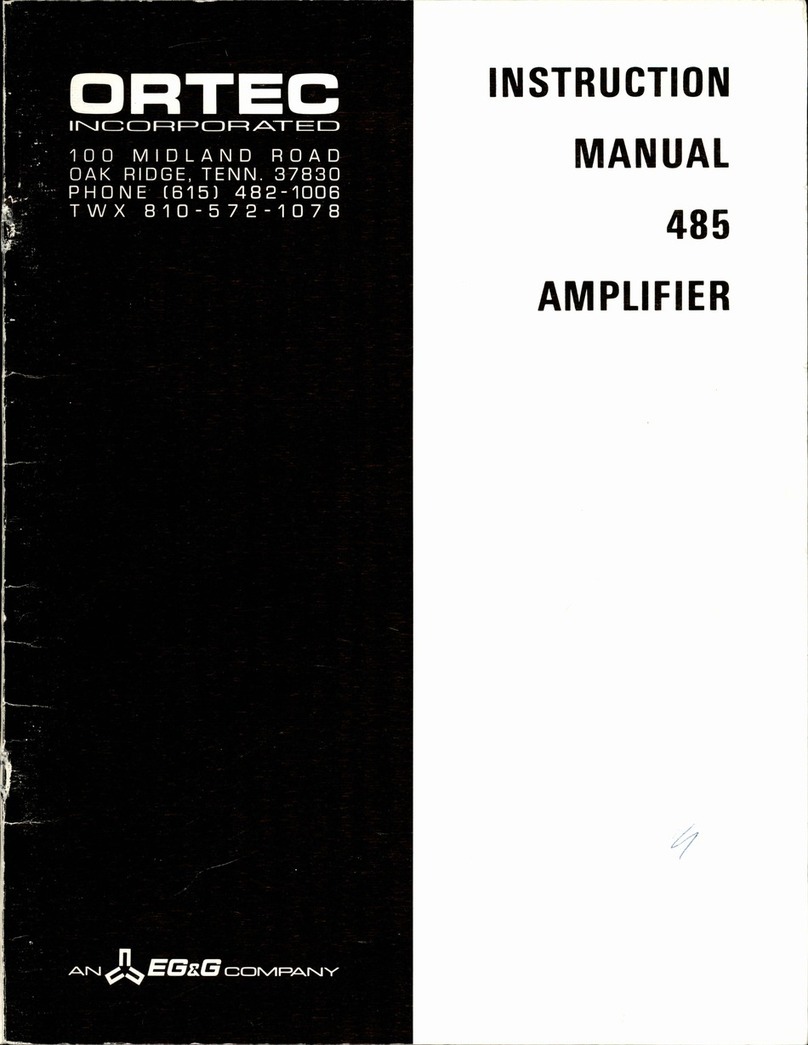
EG&G
EG&G ORTEC 485 User manual
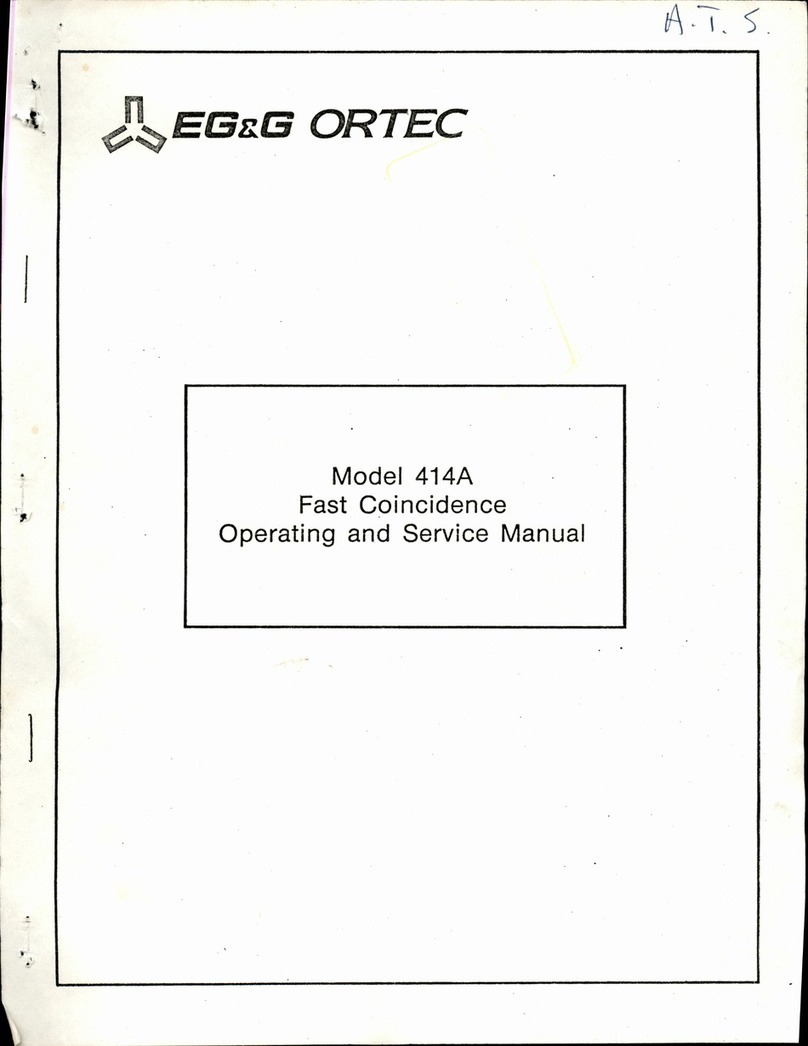
EG&G
EG&G ORTEC 414A Service manual
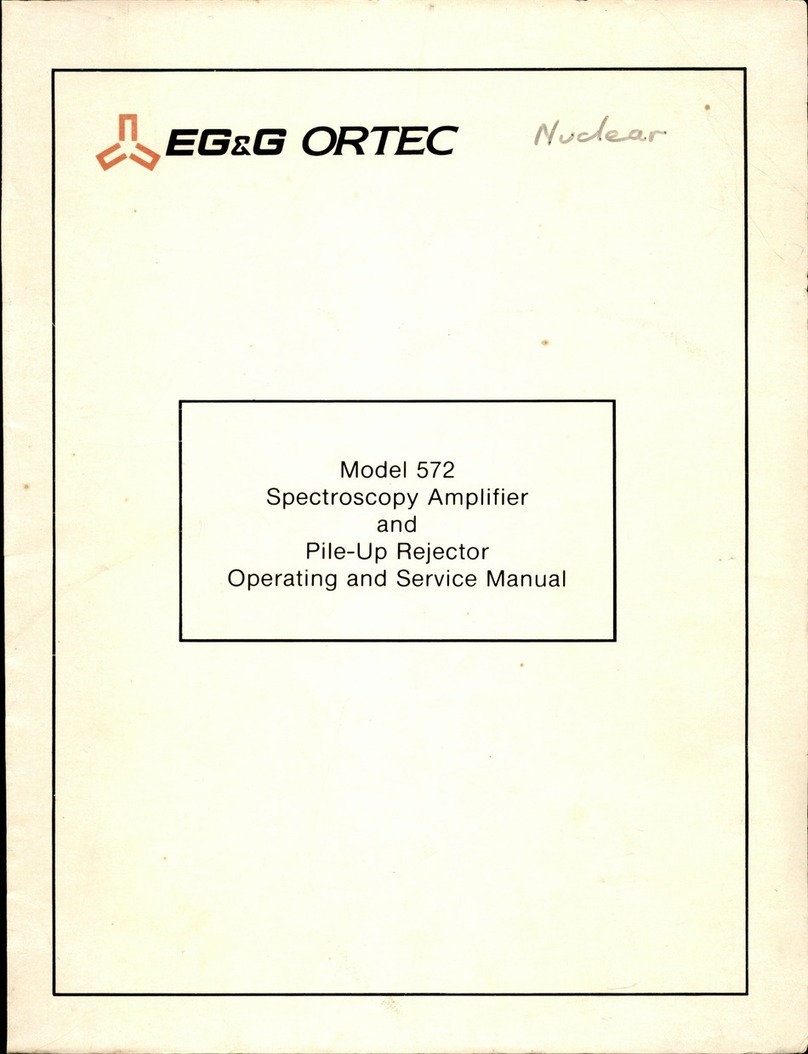
EG&G
EG&G ORTEC 572 Service manual
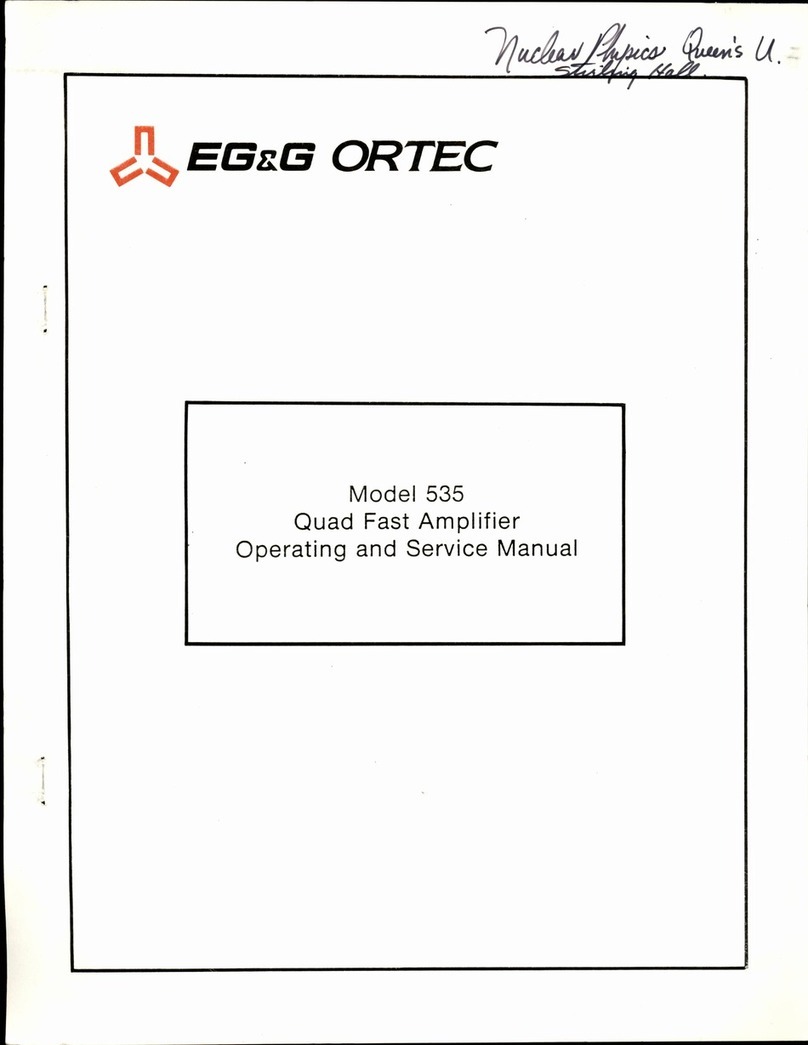
EG&G
EG&G ORTEC 535 Service manual
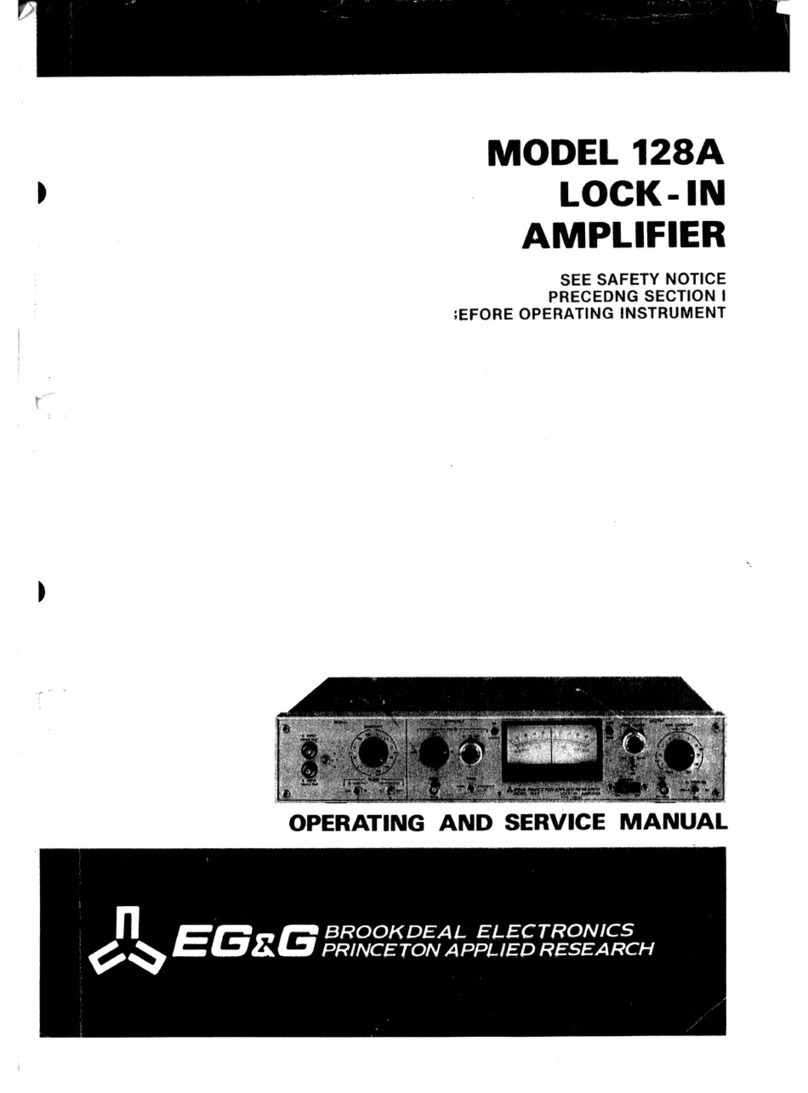
EG&G
EG&G 128A Service manual
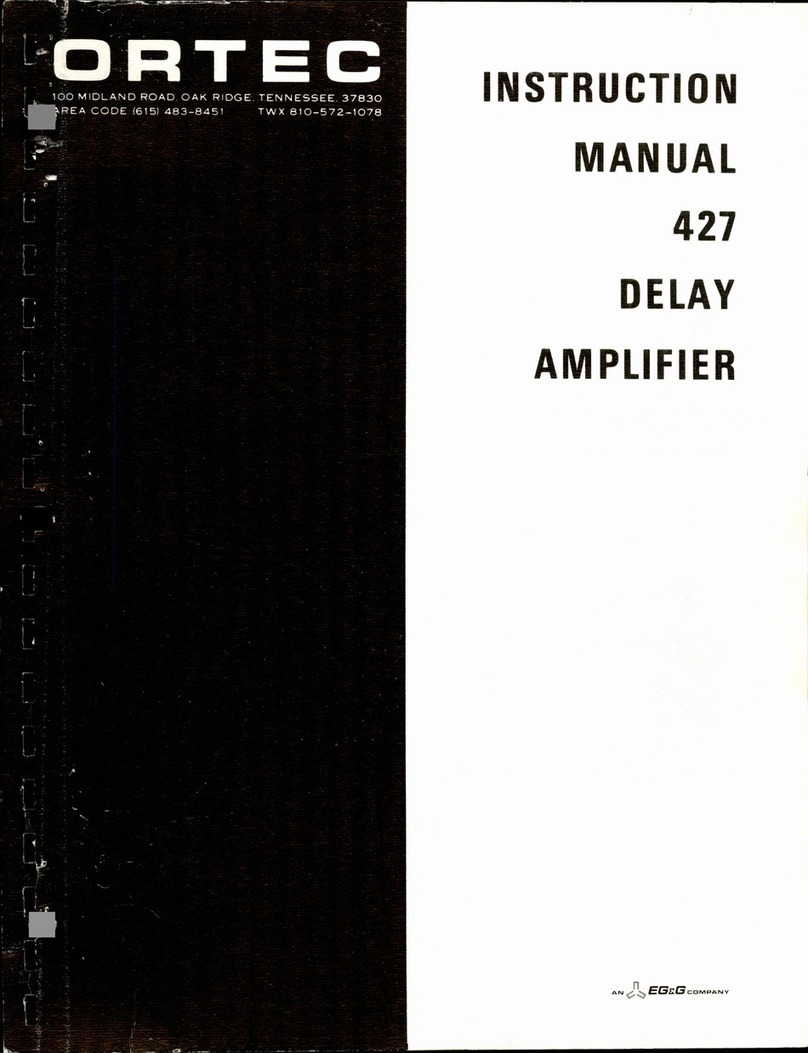
EG&G
EG&G ORTEC 427 User manual

EG&G
EG&G ORTEC 575A Service manual

EG&G
EG&G ORTEC 855 Service manual

EG&G
EG&G ORTEC 474 Service manual
